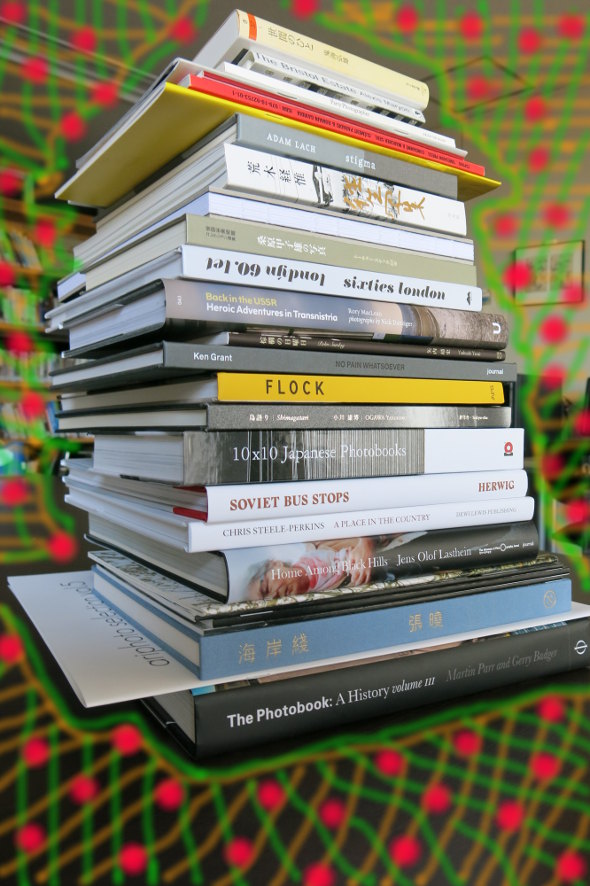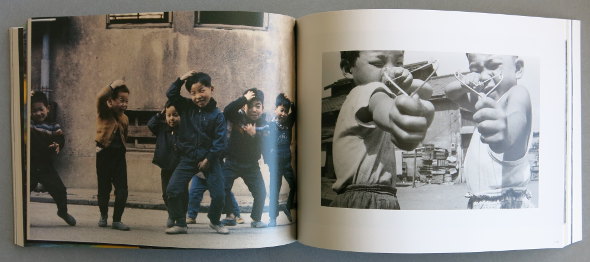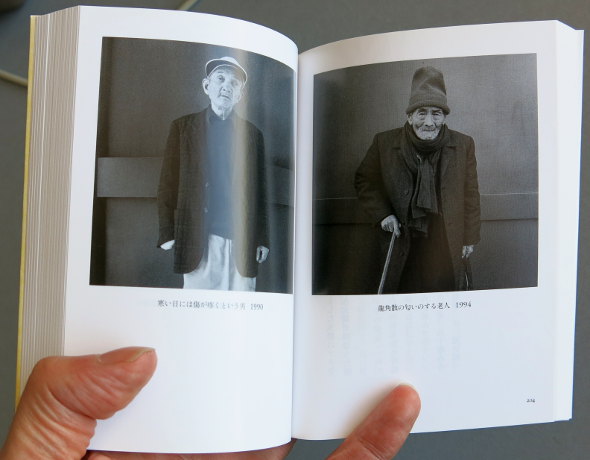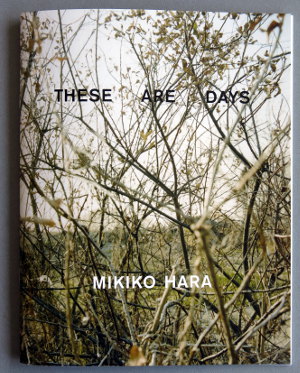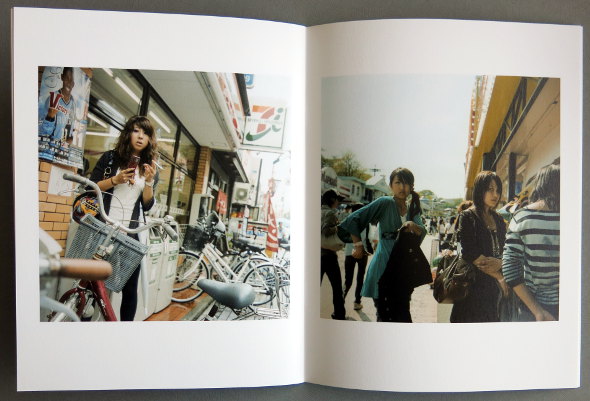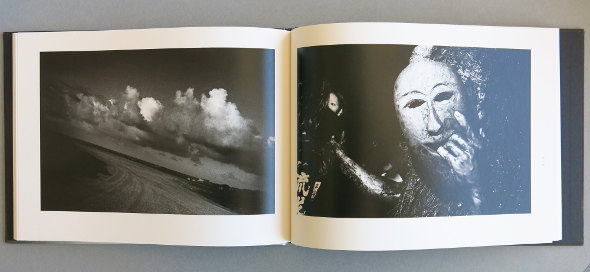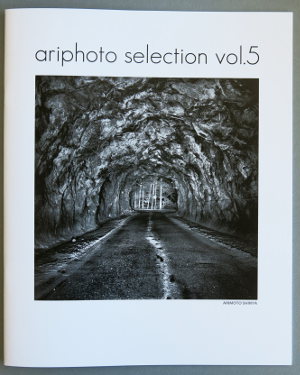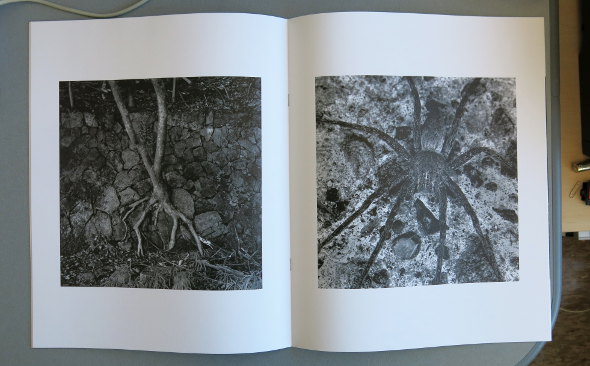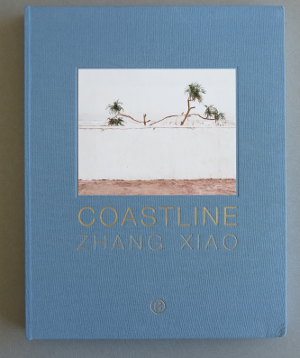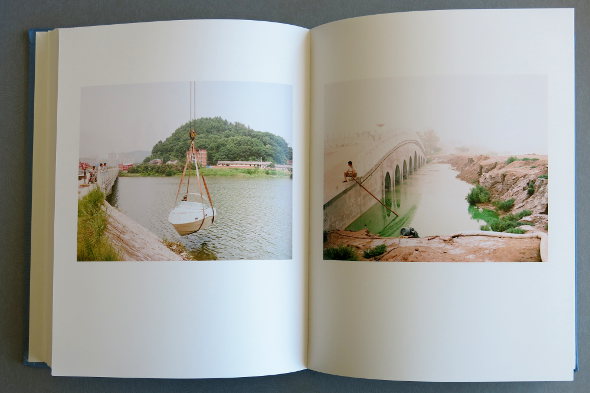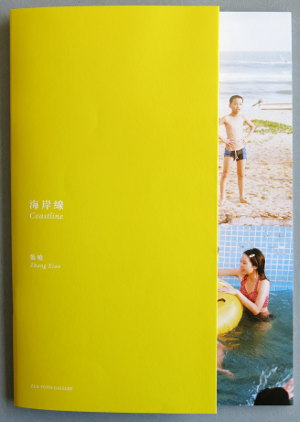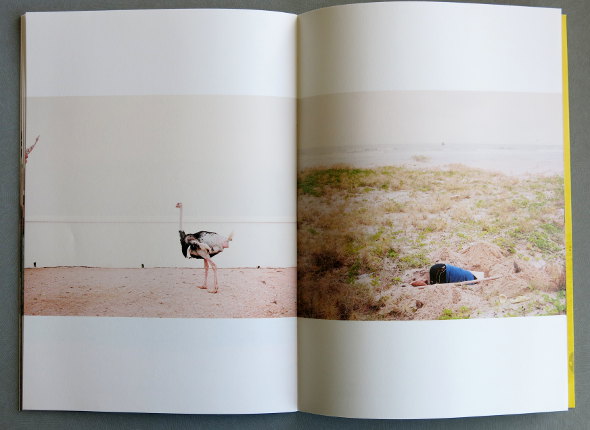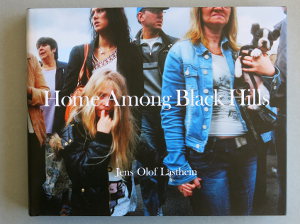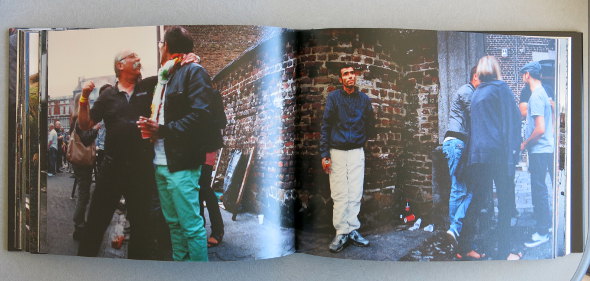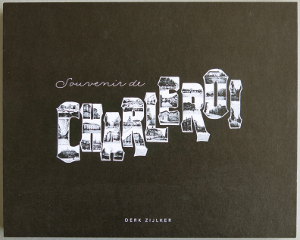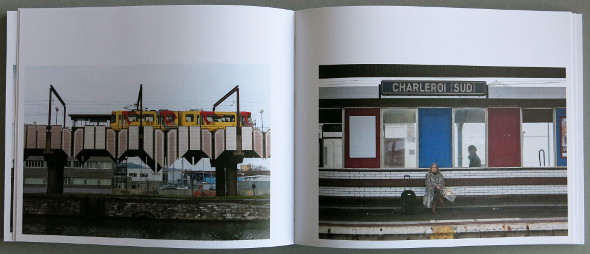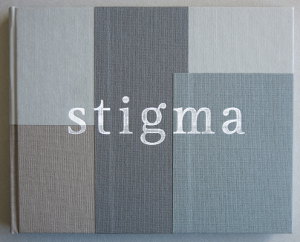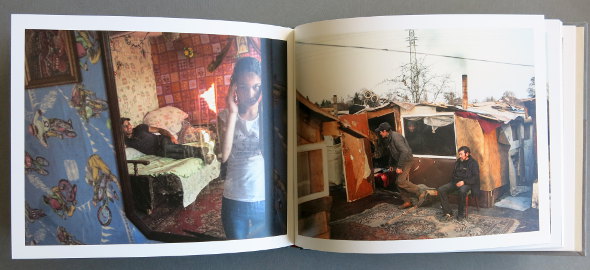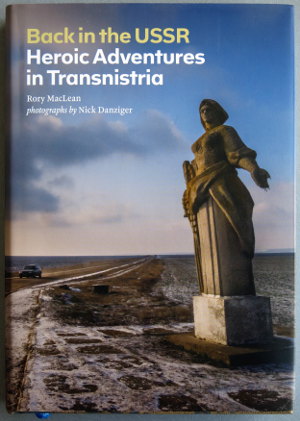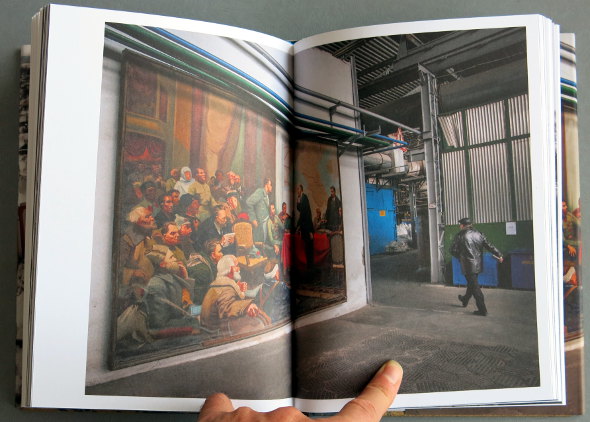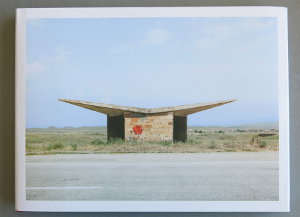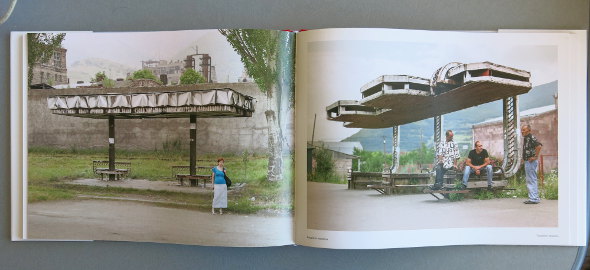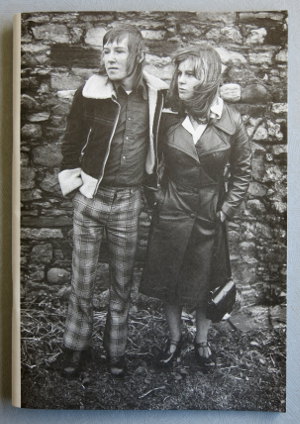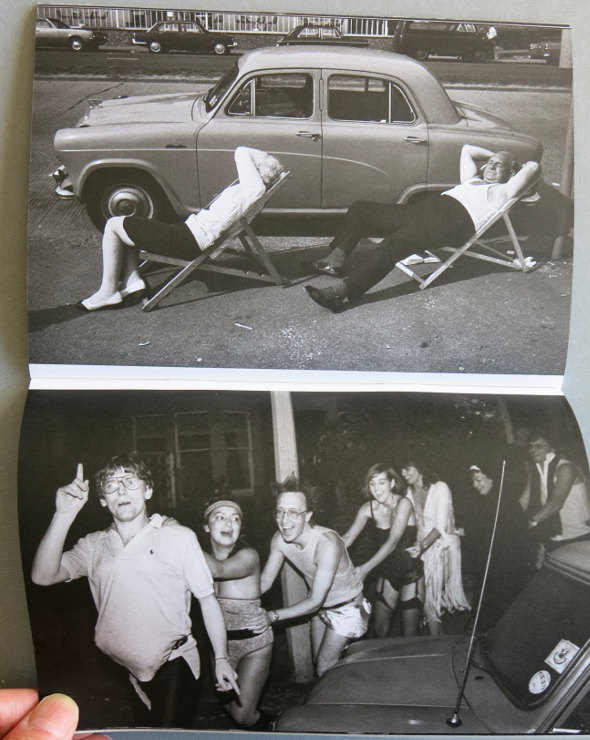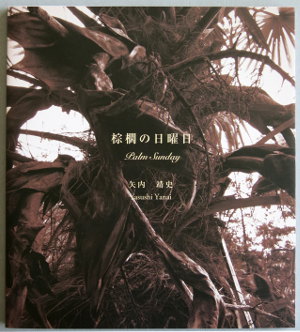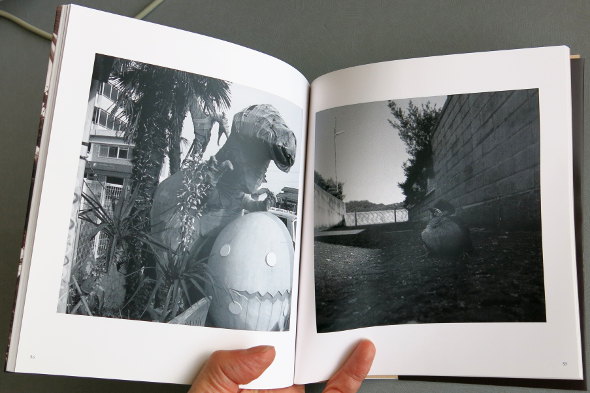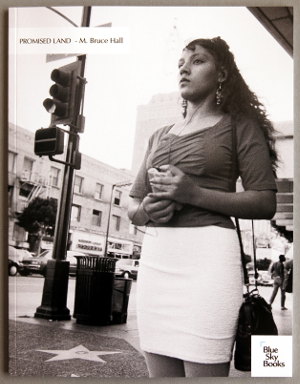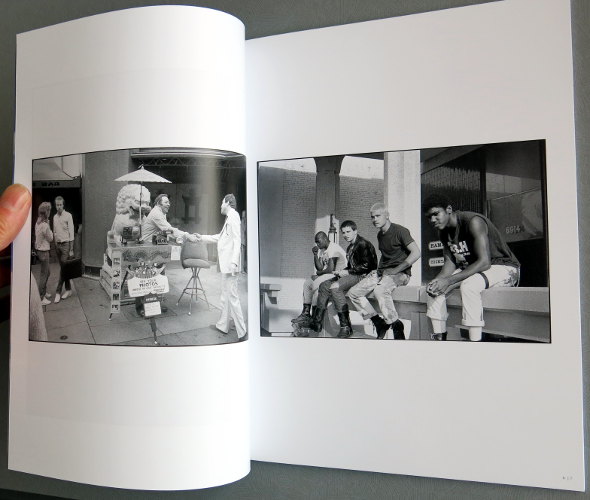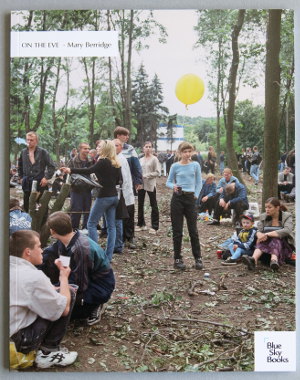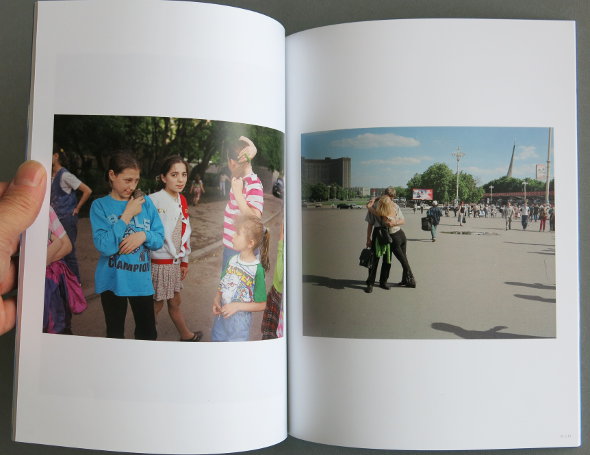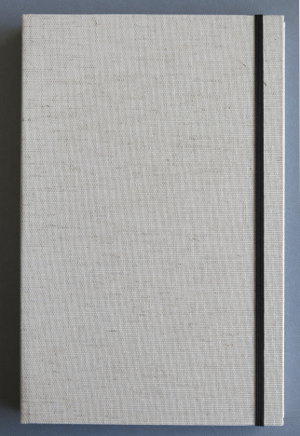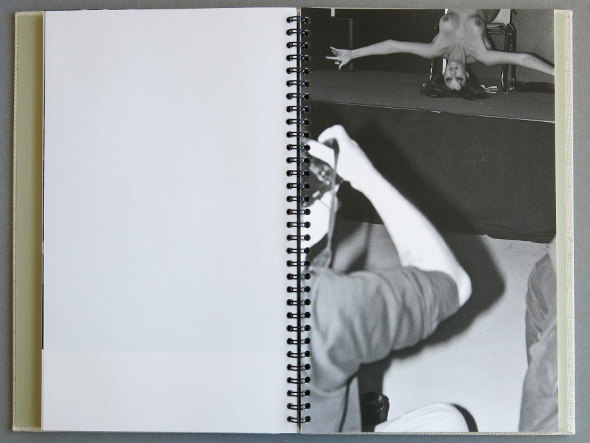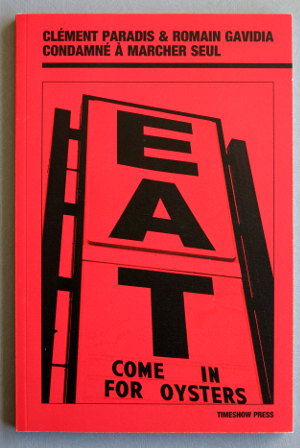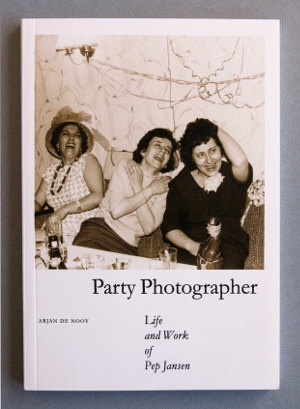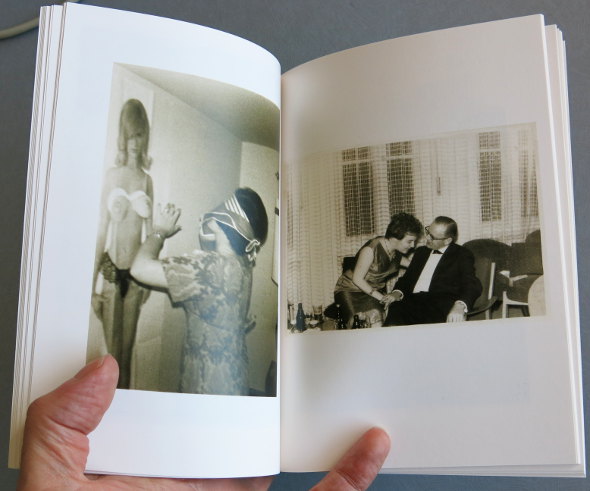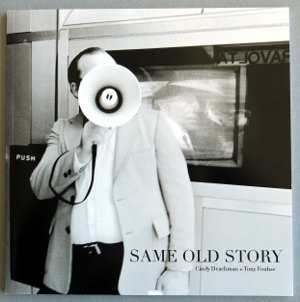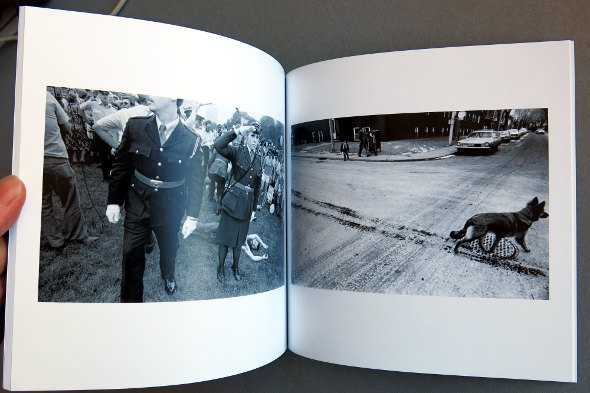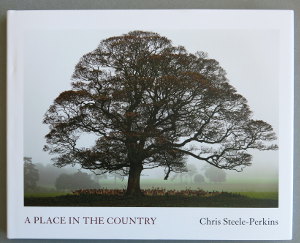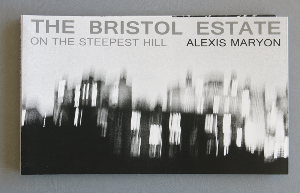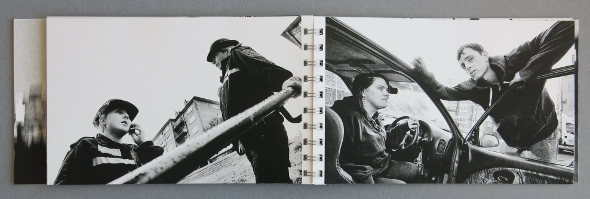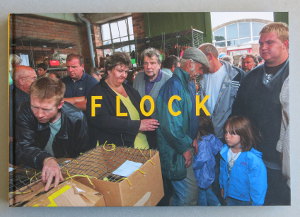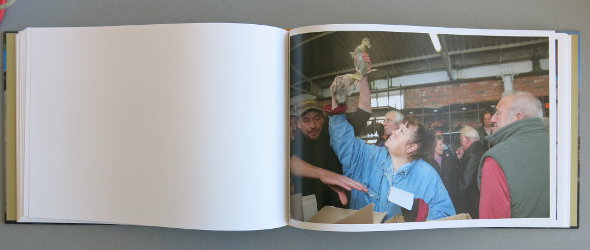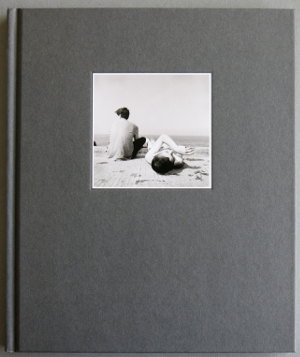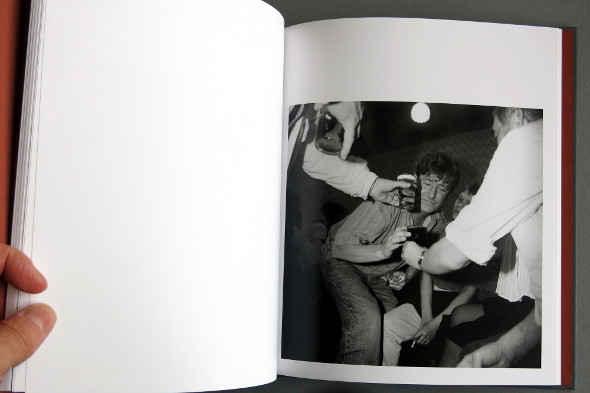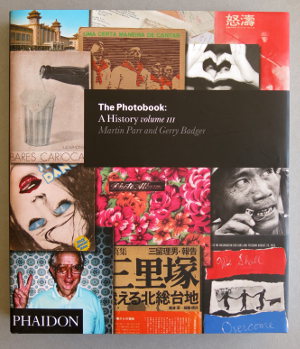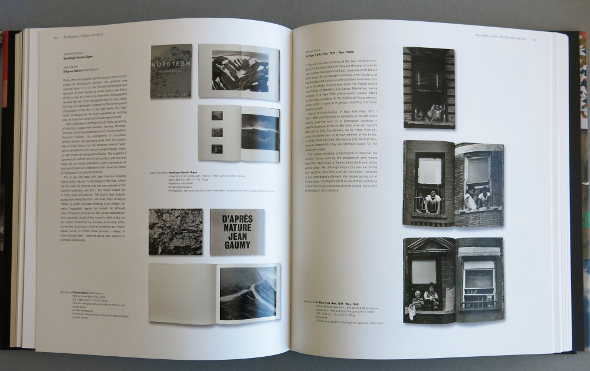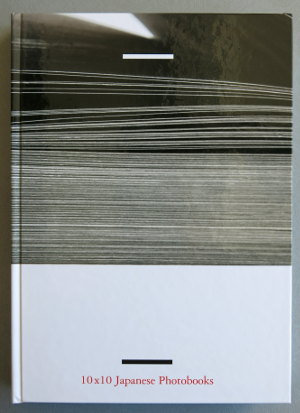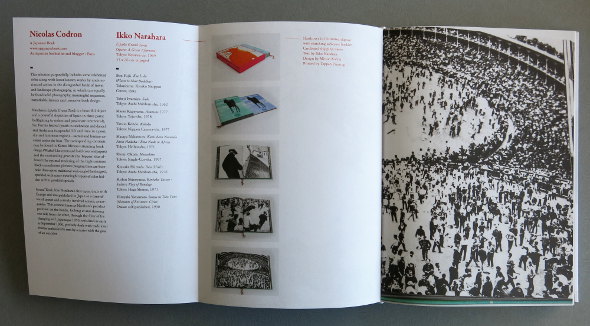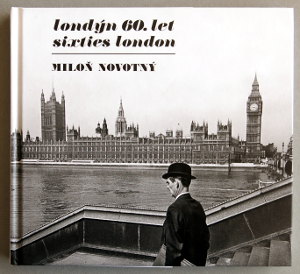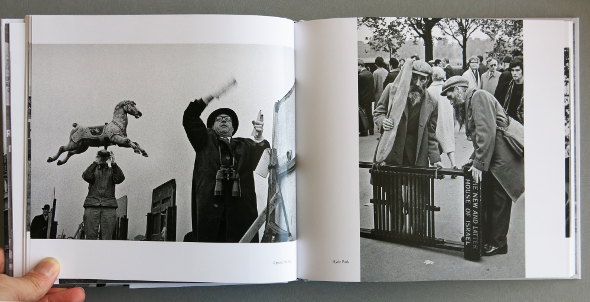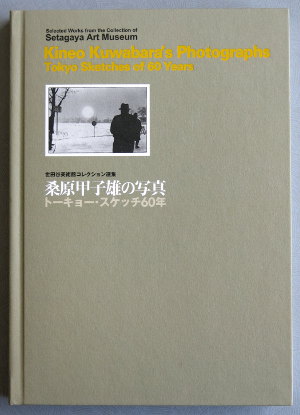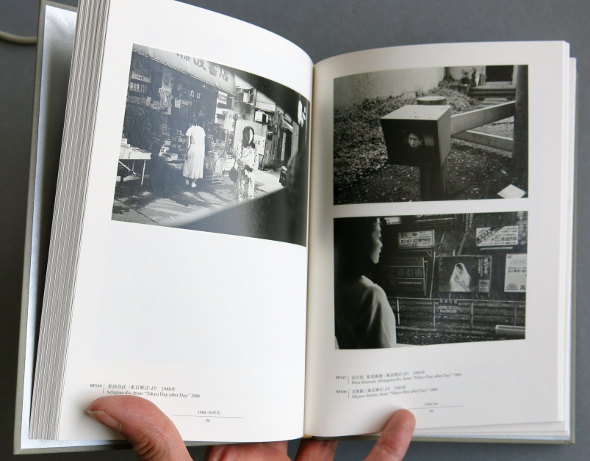a Belgian photographer in Bolivia
Posted: 28/12/2015 Filed under: Uncategorized Leave a commentEarlier this year I bought a copy of a book of political drawings by an eminent, living British artist and illustrator. (I’m not going to name names here, as I’m referring to private correspondence.) The book came with a letter (written in 1989) from the author to a person with a German name, whose identity is unclear. The letter has nothing to do with the book. Instead, much of it is about an entirely different book, a copy of which the letter seems to have originally accompanied.
This mystery book gets very high praise. The reader of the letter learns that it’s a photobook, of life at or surrounding Siglo XX, the notorious Bolivian tin mine. And that it’s by a young (in 1989), female, Belgian photographer, who subsequently returned to south America to photograph indigenous peoples.
A web search got me nowhere. Anyone have any idea what this book might be, or who the photographer might be?
a pile of 2015 photobooks
Posted: 25/12/2015 Filed under: Books | Tags: Arimoto Shinya, Bernàth Tamàs, Chris Killip, Dana Lixenberg, Dragana Jurišić, Evgenia Arbugaeva, Fukase Masahisa, Hashimoto Katsuhiko, Hayashi Tadahiko, Hayashi Tomohiko, Inge Morath, Kubota Tomoki, Laurent Chardon, Murakami Masakazu, Nuno Moreira, Samuel W Grant, Sato Haruna, Shiraishi Chieko, Siegfried Hansen, Suda Issei, Viktor Kolář Leave a comment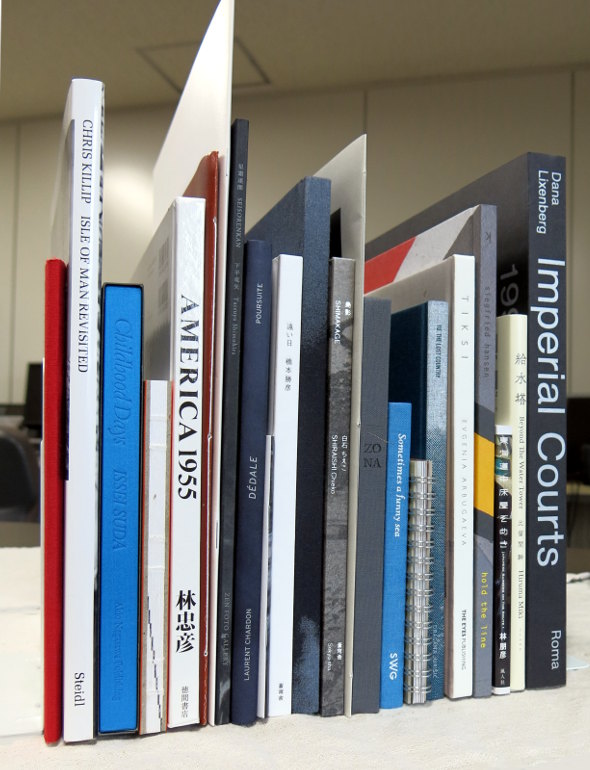
Lists of the photobooks of 2015 — you’ve already glanced at fifty; one more can’t hurt you. Here’s what I acquired during the year. And with one exception, I’m glad I did.
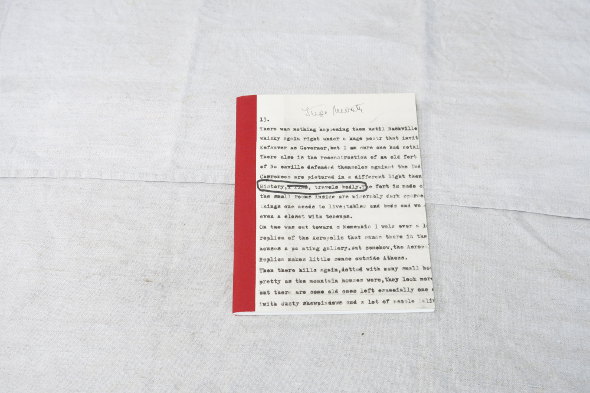
History travels badly. A booklet of miscellaneous photos by Inge Morath, interspersed with short and somewhat enigmatic quotations from her diaries. Too many of the photos are “landscape” format, so they’re either broken across the centre or (thanks to the generous margins) too small. Well, it’s a mood piece: go through this in the train and you’ll want to look through a larger book of her work in the evening. The title is a bit of a mystery: the text on the cover suggests that it’s from Tennessee at a time when Estes Kefauver was being encouraged to run as Governor, but this was an episode that even the omniscient Wikipedia hasn’t heard of. This minor mystery is a good opening for a booklet whose photos all have at least a touch of obscurity about them. It makes me want to dig out my copies of two of her other books.
Disclosure (tip of the hat to Pete Brook for this sterling idea): A friend nudged me into a crowdfunder for Danube revisited, and this was the goodie I later received.
Inge Morath, edited by Olivia Arthur and Lurdes R Basolí. History travels badly. London: Fishbar. ISBN 978-0-9569959-6-4. (Careful: this booklet seems to share its ISBN with a different book, Sudden flowers. The Morath booklet reviewed by Gabriela Cendoya.)
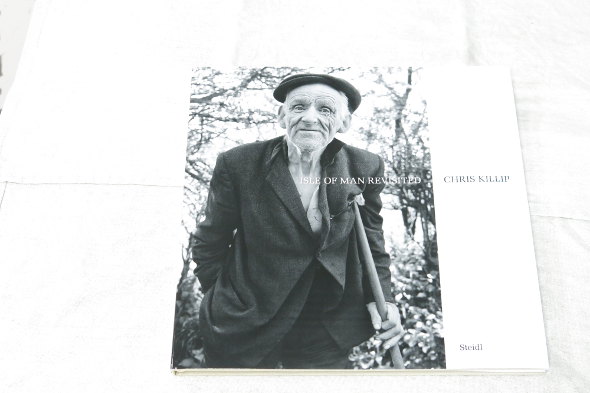
Let’s get the major disappointment out of the way first: For Isle of Man revisited, Chris Killip hasn’t revisited the Isle of Man. Instead, he and Steidl have revisited Isle of Man: A book about the Manx (1980), whose printing was about as good as anything I’ve seen from 1980 but whose page design was afflicted by lavish margins that of course resulted in small reproductions.
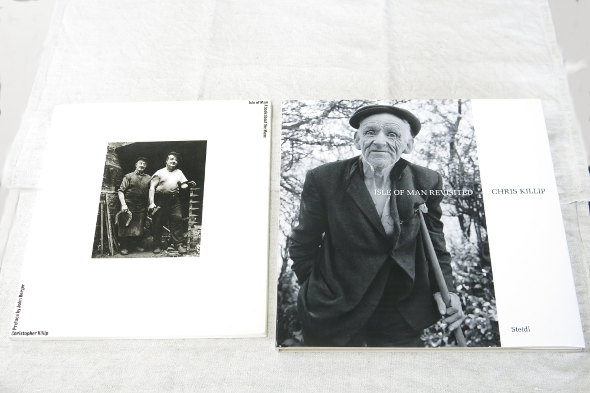
That’s the earlier book on the left. Below, the pair are the other way around:
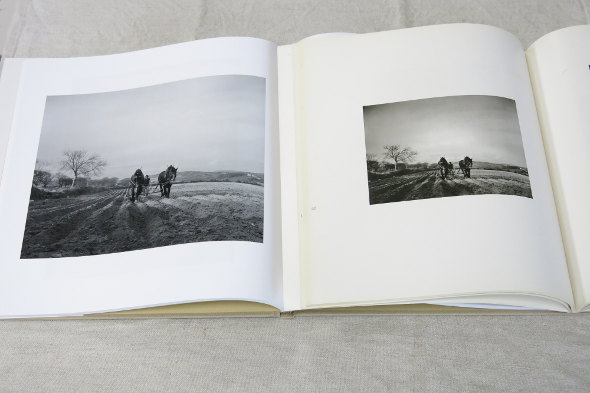
The reproductions are warmer in the older book, and in this example the older reproduction has more contrast and drama as well. So the fan of early Killip will probably want both books.
The new book brings thirty more photographs (says Killip; I haven’t counted), all reproduced much larger and of course to Steidl’s usual high standard. Here’s the Isle of Man as it was in the early seventies, but to my uneducated eye a lot of the photos could have been taken in the fifties or indeed the thirties. (Now that the island’s a tax-dodgers’ haven, I’d guess that it has all the authenticity and allure of Liechtenstein, though with duller weather.) Killip may have used the same kind of camera he later used for In flagrante; but here, as you might expect from the subject, the results resemble that book less than they do the work of Hölttö or at times even Inha.
Disclosure: Nothing. I looked at Steidl’s website (for the first time in months), and there it was. I ordered it from some company selling through the “Abebooks” arm of Amazon.
Chris Killip, Isle of Man revisited. Göttingen: Steidl. ISBN 978-3-86930-959-0. (Steidl’s page about it; review by Marc Pussemier; Killip talks about this and three other books coming out from Steidl.)
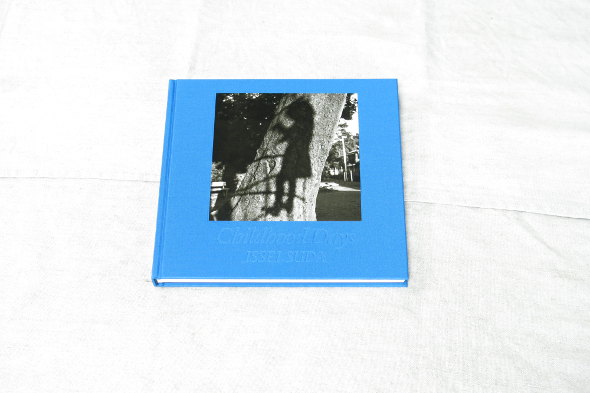
Childhood days. Suda Issei’s archive continues to be mined for bookfuls of excellent stuff . . . as well as items for the completist. In this collection, of early photographs of children, not every photo is strong, but enough are. It’s not only for completists. As is normal for this publisher, the book costs about three times as much as you’d expect. (Worse, as its stock of a book goes down, this publisher tends to jack up the price.) But the printing matches that of Early works 1970–1975 (published two years earlier): it’s as if you’re looking at a bound set of (small) photographic prints. Slimmer than and not quite as good as Early works, but not-quite-top-level Suda is still worth looking out for.
Disclosure: Nothing. I’d heard of it somewhere (I forget where); I went to some photobook fair (my one time in the whole year) and saw it there and bought it. (Also there was his inanimate fetishism book Rei, which tempted me no more than his earlier book Rubber did.)
須田一政 = Suda Issei. Childhood days. Tokyo: Akio Nagasawa Publishing. (Captions [place names and years] in roman script; afterword in Japanese and English. With one cover and with another cover at Shashasha; with one cover and with another cover at Nagasawa. Though Japan Exposures doesn’t have this, it does have other books by Suda that elsewhere are more expensive or simply unavailable.)
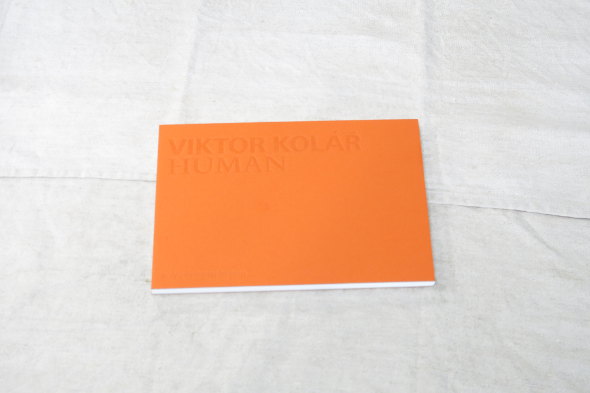
I stupidly didn’t get a copy of Viktor Kolář’s Ostrava when it came out five years ago; at the time of writing, the only copies at Abebooks are each $712 (plus $75 airmail) from some outfit calling itself “Book Deals”. And so I bought Kolář’s Human, a smaller collection of photos from the Ostrava series, and published by Only Photography, whose proprietor has excellent taste in photography. If you don’t already know Kolář, then look here; for me he was one of the main reasons to buy the book of In the face of history (I couldn’t see the show).
The book delivers about sixty photographs, printed very matt(e) and making excellent use of the page (adequate but narrow margins). Once it’s lying open on the desk, it’s excellent.
Otherwise, though . . . the book is an almost perfect rectangular cuboid, bound with one slab of cardboard at the front and another at the back. The slabs aren’t coated and will attract greasy thumbprints. If you drop the book, the lack of any overhang means a lack of impact absorbance, so what’s bound is more likely to be damaged — indeed, I saw another copy that had been dropped and the stitching at the back was coming undone. Memo to book designers: binders had mastered the art of constructing a codex by the 18th century (indeed, probably much earlier, but I haven’t examined any examples); most innovations since then have been degradations (tolerable if the degradation is minor and the saving great); go ahead and innovate if you want, but a bulky, inflexible front and back cover trimmed flush with the pages is just stupid.
Still, the content excuses the odd packaging choices. Kolář’s heroes were Cartier-Bresson, Davidson and Koudelka; and achievement matches aspiration. There are unexpected little delights here too: the woman in plate 59 (1974) — is that Velma Von Tussle from Hairspray? (And get a copy of Kolář’s Canada, 1968–1973 [2013] too, and quickly, before it suffers the fate of the Ostrava book.)
Disclosure: Nothing. I think I first heard of this book from Only Photography’s website. I went to So Books in the hope of finding a copy but did so at least a month too early. I asked for a copy to be reserved for me; it was, and I bought it.
Viktor Kolář. Human. Berlin: Only Photography. ISBN 978-3-9816885-3-5. (Text in German and English; captions. The publisher’s page about this and similarly designed books; video from PhotoBookStore.)
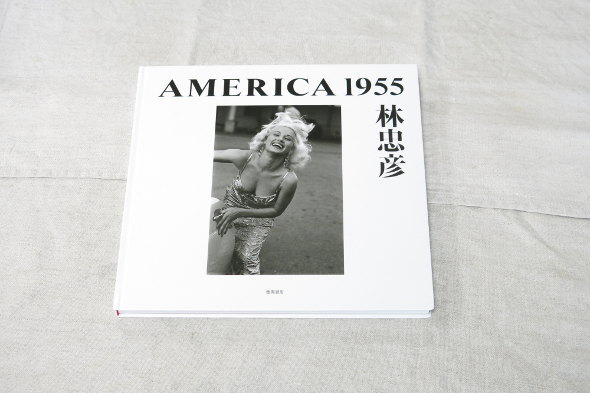
America 1955 . . . ah, let’s consider how we should approach this one:
- photographed in 1955 by Hayashi Tadahiko, a commercially successful photographer (especially of male celebs)
- Hayashi was accompanying Japan’s contestant, Takahashi Keiko, for “Miss Universe”
- contains photos of other celebs (Cary Grant, etc)
- Hayashi and his chums were dissed by Domon and his chums, who were later dissed by the Provoke generation, who themselves were (etc)
- two photos per page on quite a lot of the pages
- published by a large company that rarely if ever puts out photobooks (you can gaze in awe and horror at the top page of its website)
- cover photo shows a stereotypically blonde 1950s girl, posing for max cleavage
So Robert Frank’s America it’s not.
But the book disposes of the beauty queens in just the first (and one of the shortest) of its seven sections. As expected, these particular photos are indeed humdrum. But even in this section (on Palm Beach), one photo is first-rate street work. Some of the shots elsewhere could be by Feinstein, Faurer or indeed even Frank. (And, Araki style, a few are of Hayashi rather than by him.)
Some of this material came out in popular magazines at the time, but that was about the last time they were seen until the 1993 exhibition and catalogue 林忠彦の世界:林忠彦の見た戦後、カストリ・文士・そしてアメリカ = Tadahiko Hayashi (plain beige cover, plentiful on the used book market). But this new book is the first one dedicated to them and it’s most worthwhile.
Disclosure: Nothing. I was in Tsutaya looking for good new Japanese photobooks (and Kenneth Graves’ Home front); most of what I saw was instead the usual art school stuff but here was a lively surprise. So I bought it.
林忠彦 = Hayashi Tadahiko. America 1955. Tokyo: Tokuma Shoten. ISBN 978-4-19-863973-0. (No captions; section headings in English only; explanatory text in Japanese only.)

Slaughter. A booklet of Fukase’s photos of his lovely young wife Yōko in a slaughterhouse; I suppose partly because this was a more sensational backdrop than a junkyard, and partly because, as Yōko observed as far back as 1973, photos of her by Fukase were photos of him. Beautifully printed, and the best of these photos are excellently composed (and not at all repellent); but as a whole it’s just kitschy. Then again, I have minimal interest in the genre (whose deity is Hosoe Eikō) of elegant people striking arty poses amid the rough, rural and rude. I wish I’d bought Fukase’s new cat ’n’ Yōko book instead.
Disclosure: Nothing. I’d not heard of it, but when I paid my sole visit to a photobook fair I must have fallen for the combination of the great name Fukase and the “These are the very last copies” spiel.
深瀬昌久 = Fukase Masahisa. 屠 (To) = Slaughter. Kamakura: Super Labo. ISBN 978-4-905052-81-4. (Review by Olga Yatskevich; video.)
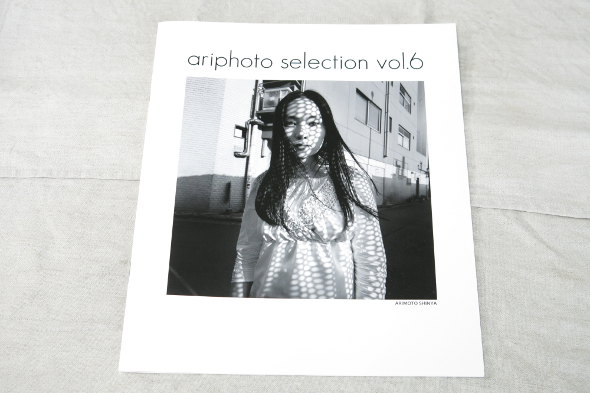
Arimoto Shinya is up to vol. 6 of Ariphoto selection. Big, square B/W as always; and here it’s back to street portraiture: 18 photos, well reproduced, cheap. If only I had wall space, I might have cut up an extra copy and framed the individual pages. (Not that his prints are overpriced: on the contrary.) Ariphoto has been exhibited in Goa; some year soon, Europe and the Americas might catch up.
Disclosure: Nothing in particular. I know the photographer, but not at all well. (We’ve only ever met at Totem Pole, as far as I remember.) There was a pile of vol. 6 at a recent Ariphoto show at Totem Pole, so I bought one from him.
Arimoto Shinya (有元伸也). Ariphoto selection vol. 6. Tokyo: Totem Pole Photo Gallery. (No captions or other text. Heads up at Tokyo Camera Style. Vol. 6 was here within Arimoto’s website, but it has sold out. As have all the five earlier volumes. If there’s ever a volume 7, here’s where we’ll learn of it.)
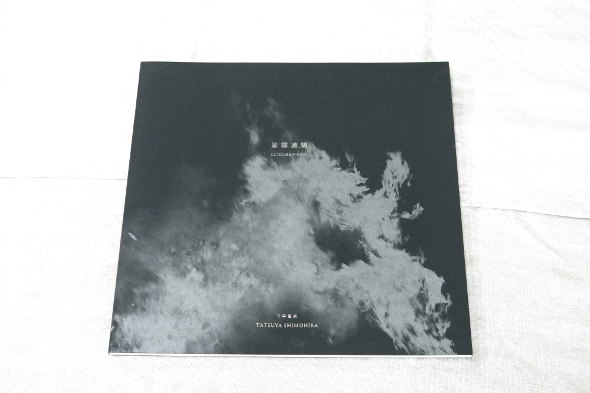
Seisorenkan is the largest, handsomest and best of what I’ve seen among Shimohira Tatsuya’s numerous slim books. Forty or so square B/W plates, of nature, festival events and trappings, festival participants, and more. If it’s reminiscent of Suda and Arimoto (and Kai Keijirō), then who better? I just wish that there were explanations of what we’re looking at. (David Goldblatt’s reputation has survived his provision of explanations.)
Disclosure: Nothing. I’d seen the book at Zen Foto but hadn’t paid attention to it (perhaps because of its formidable page size); however, in my sole visit to a photobook fair I looked in it again and it was good. I did meet the photographer, but only nominally: we exchanged pleasantries and he signed.
下平竜矢 = Shimohira Tatsuya. 星霜連関 (Seisōrenkan) = Seisorenkan. Tokyo: Zen Foto Gallery. (No captions or other text. Here within Shimohira’s website; here at the retailer Shashasha.)
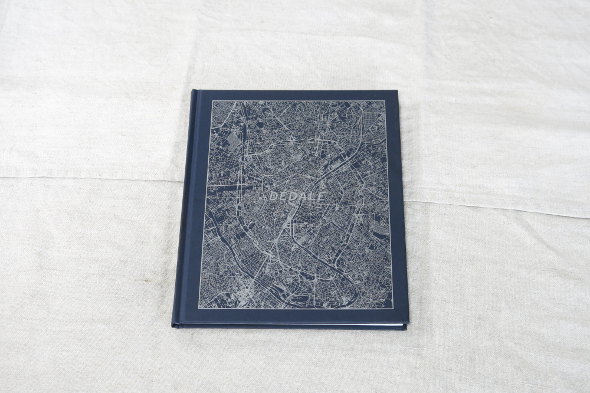
Dédale is Laurent Chardon’s view of crepuscular and nocturnal Paris. We’ve come a long way from Izis: this Paris is dark, decaying and somewhat menacing (though with no cheap effects). Gatefolds show a series of head ’n’ shoulders shots of people making their way through the big city: I think of Joseph Selle and In this dark wood.
Dédale left me a bit blank on first acquaintance but it has since become one of the most intriguing of this year’s bunch. There’s no indication of where in or around Paris the photographs were taken, or indeed of what Daedalus has to do with Paris (though I’ll guess that the title points to the city’s labyrinthine character).
Disclosure: Nothing special. I think I first noticed this at Poursuite’s website. I knew the photographer’s name and we’d years before had a brief email exchange over his Tangente. I ordered the book from Poursuite.
Laurent Chardon. Dédale. [Paris]: Poursuite. ISBN 978-2-918960-82-9. (No captions and, aside from acknowledgments, no text. Its publisher’s page about it; Chardon’s page about it; reviews by Hélène Delye and Jonathan Blaustein; video.)
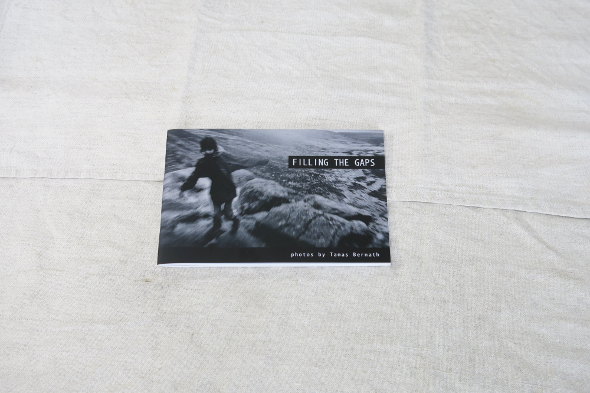
Filling the gaps:
From 2010 to 2011, having finished our studies, and feeling the need to get away for a while before settling down, my girlfriend and I spent a year in a life-sharing community in Ireland. We lived and worked with people with special needs. These photos are a record of that year.
So says Bernàth Tamàs. It’s a fine record and when he brings out an actual photobook (of this or anything else) I want to see it. Meanwhile, this is marketed as a zine and priced like a zine; but both the photography and the printing are far above what I dare expect from a zine.
Disclosure: Nothing. I’d heard of neither the booklet or its photographer until I saw the former at the Independent Photo Book. I ordered my copy from the photographer.
Tamas Bernath (Bernàth Tamàs). Filling the gaps. [Budapest]: the photographer. (A tiny edition, but luckily no mention of “limited”; this deserves a second edition. Book and many of the photos in Bernàth’s website.)
PS (28 Dec): There’s an interview with Bernàth here.
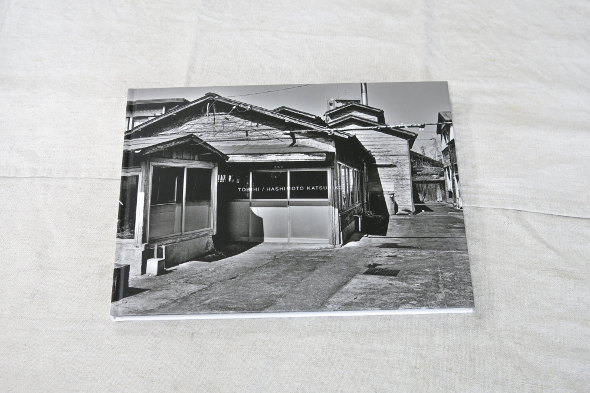
Tohihi: views of well-worn Japan. Hashimoto Katsuhiko waited seventy years before the first book or exhibition of his that I know of; at seventy, he was up to the task of photographing sleepy Japanese structures even if the printing company wasn’t. But that was for the 2012 book もう一つの風景 (Mō hitotsu no fūkei) = The other scenery; three years later he’s back with a new collection: more, bigger and far better reproduced plates (though still in a tiny edition). A few of the buildings here are neat, but most are more or less ramshackle and some seem in danger of collapse. There’s heavy dependence on cheap wooden slats, corrugated iron and nails. They’re the kind of buildings I enjoy seeing when out on a ride.
Disclosure: Nothing. I happened to notice the book while Sōkyūsha’s bookshop, partly because I remembered the photographer’s name from his first book. I liked it; I bought a copy there and then.
橋本勝彦 = Hashimoto Katsuhiko. 遠い日 (Tōi hi) = Tohihi. Tokyo: Sokyu-sha. (Captions give placenames in both Japanese and Roman scripts; afterword in Japanese and English. The Roman-letter title is spelled idiosyncratically [there’s no /h/ sound]; the title means “a/the distant day(s)”. Here at Sokyusha; here at Shashasha.)
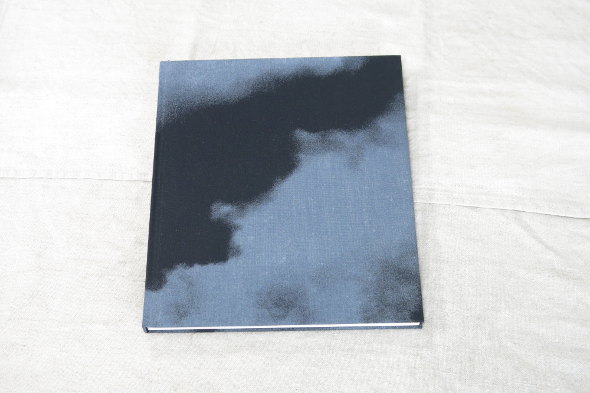
In Kumogakure onsen, Murakami Masakazu presents photos from the start of the century of onsen and surroundings. They’re dark, grainy, and sometimes blurred, rather in the Moriyama style (for which my appetite is very limited). The people look a bit blank; are they perhaps a little bored? (Boredom quickly overcame me during my one visit to an onsen, and that was a long time before attention deficit hyperwebsurfing disorder made unthinkable the prospect of lying in a bath for ages.) I prefer the unpeopled scenes, of funky street scenes and interior decor, etc. The book costs less than the train to and from an actual onsen, I can keep my clothes on (or indeed stay completely undressed) as I go through it, and my phone won’t get wet.

The book is a reworking of Kumogakure onsen yuki (雲隠れ温泉行き), published in 2007 (and on the left above). The earlier book is well produced in its way, and copies are easy to find and cheap — but most photographs are printed across double page spreads and thus disfigured by the gutter. This new book doesn’t cost much more and I think it’s far superior; but in order to escape disfigurement, the “landscape” format photos are printed much smaller than in the old book. Take your choice.
The older book:
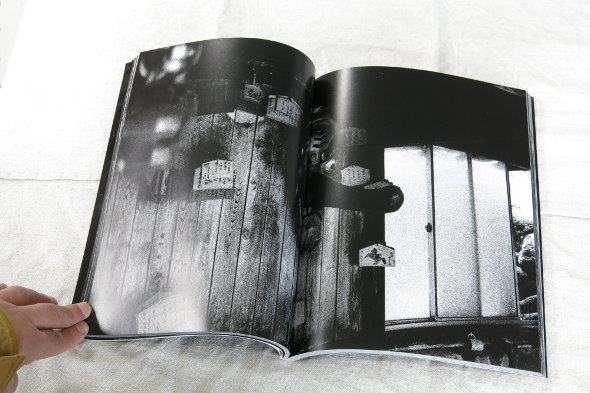
The newer one:
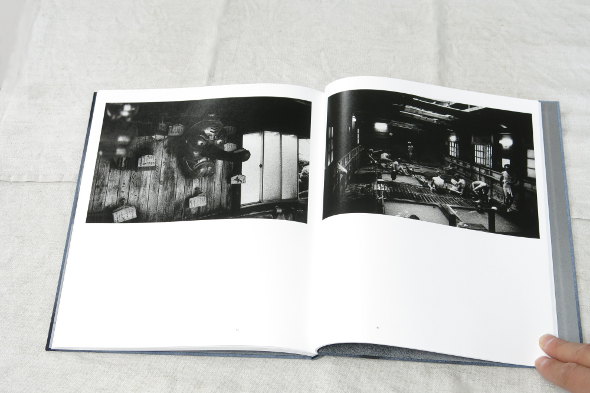
I’ll take smaller and undisfigured, thanks.
Disclosure: I’ve met the photographer a couple of times, I think. But it would have been a couple of years ago and I may be mixing him up with somebody else. I saw the book, I liked it (but the content looked familiar); I forgot about it; later I saw it again somewhere (I forget where) and liked it and bought it. (My copy came with a small print.)
村上仁一 = Murakami Masakazu. 雲隠れ温泉行 (Kumogakure onsen yuki) = Kumogakure onsen: Reclusive travels. Tokyo: Roshin. ISBN 978-4-9907230-2-6. (Captions give placenames in both Japanese and Roman scripts; afterword in Japanese and English. The main title means “hot springs hidden in clouds”. Roshin’s page about the new book; Shashasha’s page; Book of Days’ page.)
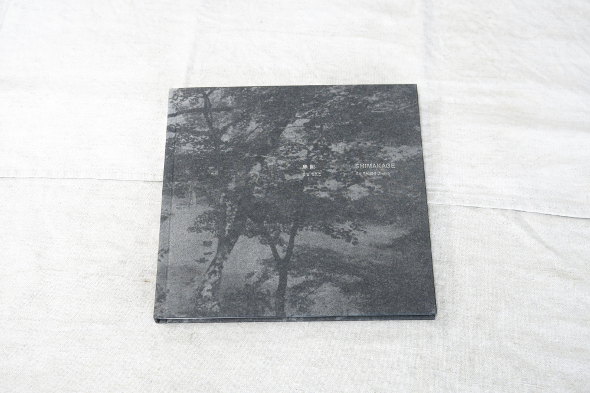
Shimakage has forty-five or so black and grey photographs of coastal and other scenes.
“The works are gelatin silver prints utilizing a retouching technique called zokin-gake (rag-wiping) popular among amateur photographers in Japan during the 1920s and 1930s.” Once we’ve deciphered meaning from the dark greys (a process I enjoyed; not all will) there are a handful of more or less conventional landscapes, but rather more of antipictorialism. I enjoy teasing out meanings from the dark images, but not everybody will.
Disclosure: Nothing. I happened to notice it while Sōkyūsha’s bookshop, and bought a copy there and then. It’s the photographer’s second book, but I don’t recognize her name or (now that I google for them) the cover or title of her first one.
白石ちえこ = Shiraishi Chieko. 島影 = Shimakage. Tokyo: Sokyu-sha. (Captions give placenames in both Japanese and Roman scripts; afterword in Japanese and English. The title means “island shadow”. Exhibition at Morioka Shoten (before that moved and became world-famous); here at Sokyusha; here at Shashasha.)
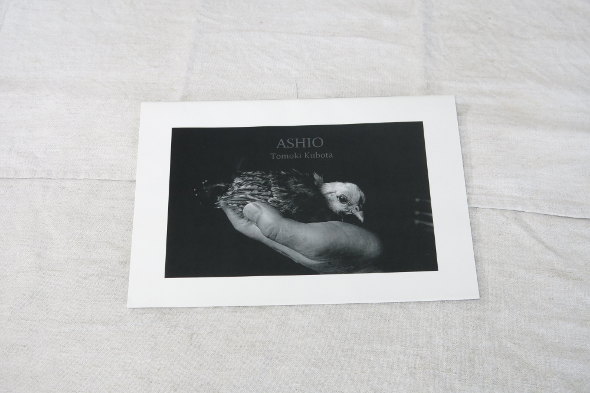
Kubota Tomoki’s Ashio shows Ashio, once the site of a copper mine, severe environmental degradation, and richly deserved riots. The mine closed in 1973. (I suppose that the copper I now consume comes from Congo-Kinshasa or some similarly wretched part of the world. But of course I try to avoid thinking about this.) Kubota’s booklet of 18 B/W photos doesn’t show lingering pollution in any obvious way; Ashio seems a placid place. There’s variety here and the modest scale is just right.
Disclosure: Nothing. I happened to notice it in Sōkyūsha’s bookshop blog, looked out for it the next time I was in the shop, found it, and bought it there and then.
久保田智樹 = Kubota Tomoki. 足尾 = Ashio. [Tokyo]: Red Stream Photography. (No captions, no text, aside from a bilingual colophon. My copy came with a little print. Red Stream’s Facebook post; here at Sokyu-sha.)
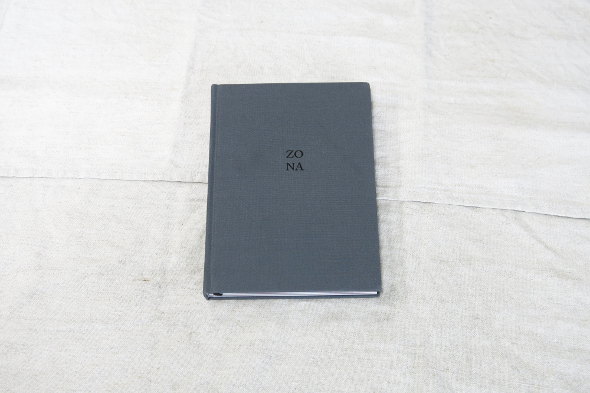
Very unlike State of mind, Nuno Moreira’s previous book, Zona has interior photographs of a girl: her back, her arms and legs, a chair, a table, dried flowers, etc — but mostly the girl. Lots of chiaroscuro, for composition is most important here. There’s bare skin; but I doubt that anyone will find this erotic, or indeed unerotic — it’s doing something quite different. Photographs alternate with trilingual text; both are oneiric but I confess that the text befuddled me (after not much reading, I started to skip it), whereas the photographs continued to fascinate. A very smartly designed package.
Disclosure: I know the photographer, but now that we’re at opposite ends of Eurasia we seldom meet. I was BCC’d in mail he sent to announce the new book; I bought a copy like anybody else.
Nuno Moreira. Zona [Lisbon]: the photographer. ISBN 978-989-20-6083-5. (Text by José Luís Peixoto in Portuguese, Japanese and English. Here and here at Moreira’s site; here at Josef Chladek’s site; review by Christer Ek.)
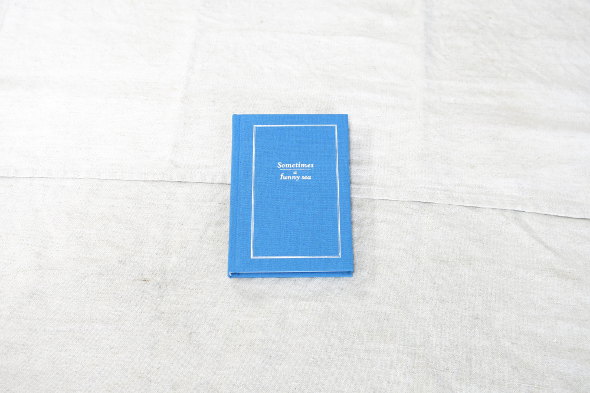
“5 4 3 2 1”, announces the copyright page of Sometimes a funny sea: five printings envisaged, so none of the “limited edition” mumbo-jumbo here, it seems. Though perhaps Samuel Grant is playing around with the book design here. Close to the format of a bunkobon, the book is divided into “Postcards from Europe”, “Polaroids & other pictures (mostly America)”, and “Mexico”; it ends with “The End”. There are landscapes, townscapes, portraits and more, totalling a hundred or so. The reproductions are small and you want — or anyway I want to look closer. There’s some shallow-focus trickery that I suppose was achieved with a tilting lens; and some ageing of the prints (a lot more subtle than what certain hyped photographers are doing these days). If you’re looking for a photobook to read on the train, here it is. Though it makes for enjoyable reading anywhere.
Disclosure: I had La Rue (and had a brief email exchange with the photographer a couple of years back). So when this new book was announced at the Independent Photobook blog I recognized the name. I bought a copy, paying for it like anybody else. (And after I received it I thought a friend would like it so I bought a second copy too.)
Sometimes a funny sea: Selected photographic works by Samuel W. Grant. No place specified: the photographer. (Here at Fluidr; here at BigCartel; here at Storenvy.)
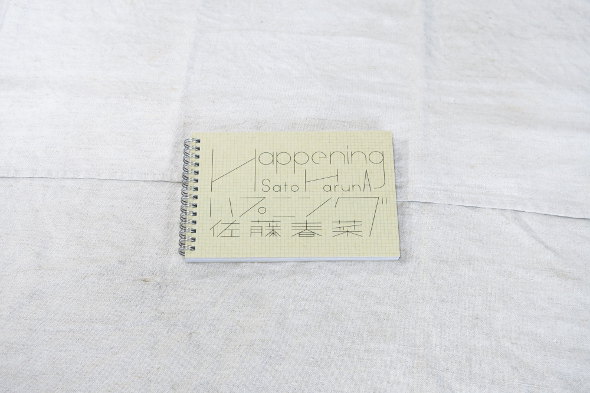
Happening relates Sato Haruna’s misadventures in a short trip to Kuwait that was almost a non-trip . . . but she came out all right in the end. The misadventures themselves didn’t lead themselves to photography; but here’s a good pile of photographs for such a short trip. Though I’ve never been so enthralled by her continuing Ichi no hi series, I did always like her small shows of (B/W) photos from her lightning trips to various places around the world; I hope this little book is a sign that there’ll more of this.
Disclosure: I know the photographer, though not well. I didn’t know of this book. When I paid my sole visit to a photobook fair, there was the photographer, who discreetly drew it to my attention. I bought a copy, on which she drew a little camel for me. (But I think she’d do the same for you, if you asked politely.)
佐藤春菜 = Sato Haruna. ハプニング (Hapuningu) = Happening. Tokyo: Kaido. (Text in Japanese and English. Order from here.)
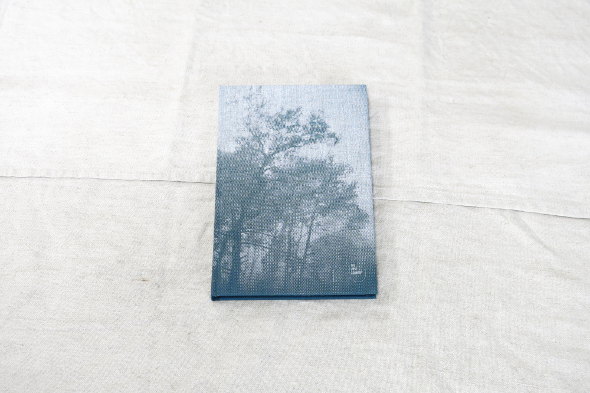
YU: The lost country is a small, slim book, inspired by Rebecca West’s Black lamb and grey falcon (which I haven’t read): the exile returns to a place once named Yugoslavia but now sternly divided, as a result, I suppose, of tribalism, gangsterism, fear and stupidity. Dragana Jurišić is not at all happy with what she experiences, and finds West extraordinarily insightful and prescient. Jurišić’s good with the little text observation; for example (in Bosnia and/or Herzegovina): “Looking at the shops by the side of the road; curtains, garden gnomes, plaster swans and tombstones. This country is fucked.” Well, yes, but it does get me thinking: Kitsch is almost everywhere; couldn’t the same observation be made in many countries? (In Nicaragua, for example, it’s government policy.) And yes, those countries are probably fucked too, but I don’t know how such observations show it. (I’d look at the Corruption Perceptions Index and the consumption of heroin, for starters.) But I mustn’t be too literal-minded: this is a photobook, not an OECD report. There’s more text by Jurišić and more from West’s book (whose prose can be purplish); and of course there are Jurišić’s photos (plus some from the past). Some of these are arresting (the birds in the tree, the man with the dandelion).
For me the book doesn’t quite add up, when I think about it. But when I just browse through it, it works; and I do want to browse through it again. So I’ll hang on to YU (together with B, BY, IS, RUS and U). Yes, it’s compelling (and it’s excellently produced).
Though when I turn to Tomasz Wiech and Michał Olszewski’s Poland: In search of diamonds, I wish they’d turn their wry sensibilities to what was once Yugoslavia (or indeed to anywhere else).
Disclosure: Nothing. Sean O’Hagan’s review of the book interested me so I bought a copy from the photographer as any other interested reader might.
Dragana Jurišić. YU: The lost country. [Dublin]: Oonagh Young Gallery. ISBN 978-0-9929641-1-5. (Here on Jurišić’s website, but already out of print; video.)

Tiksi (Тикси) is on the northern shore of Russia: 71°39′N, with recorded temperature extremes of 34° and −50° and a population of about five thousand. So says Wikipedia. It’s where the photographer Evgenia Arbugaeva comes from. With the help of a girl she met there by chance and who appears in many of the photographs, she portrays Tiksi as, or turns it into, a magical playground. Russia’s far north isn’t an unexplored subject — Ville Lenkkeri’s The place of no roads and the wreckage of Alexander Gronsky’s Norilsk and more — but this is an unfamiliarly appreciative and affectionate view.
Disclosure: Nothing. I saw some of the photos on the Guardian website before there was any mention of a book; later, when I saw a book mentioned, ordered a copy from Book of Days (excellent packing and service).
Evgenia Arbugaeva (Евгения Арбугаева). Tiksi. Paris: The Eyes. ISBN 979-10-92727-03-6. (Text in English. There are generous sets of JPEGs here and here; and here’s an interview with Arbugaeva and Tanya.
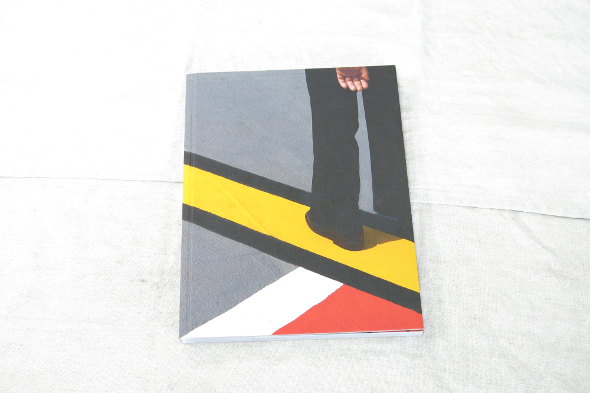
Hold the line: Siegfried Hansen is in In-Public but it’s not what you’d expect . . . perhaps Keld Helmer-Petersen meets Alex Webb: anyway, all bright colours and sharp lines. It’s street design serendipity. There’s certainly a human element: the cover shows half a leg, a quarter of another leg, and half a hand. A woman is at work in an office seemingly suspended over a vertiginous view of what looks like Tokyo (though I can’t quite place it), with tiny, distant signs advertising Marui, Megane Supā and more.
The book had a big impact on me at first sight; but I didn’t want to linger. Returning to it later, I see things I’d missed — and what seemed obvious turns out not to be.
Disclosure: Nothing. It looked good in Colin Pantall’s review, so I ordered a copy from the “Book Depository” (ie Amazon) via “Abebooks” (ie Amazon).
Siegfried Hansen. Hold the line. Dortmund: Kettler. ISBN 978-3-86206-435-9. (No text. Seemingly out of print at its publisher, but the book doesn’t mention that the edition is “limited”, so we can hope. Or you could try writing to Hansen. Its publisher’s page about it; Josef Chladek’s coverage.)
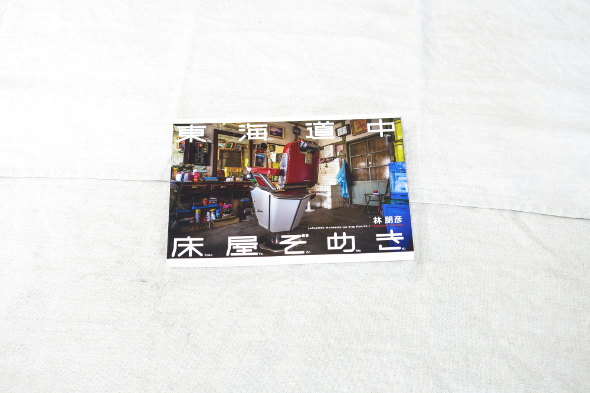
Japanese barbers on the route 1 brings you 92 views of barbers’ establishments along Tōkaidō or route 1. A generation ago people in Tokyo wouldn’t have imagined that most cafés would be chainified (Doutor, Crié, Veloce, Starbucks, etc); a generation from now I’d guess that barbers will be chainified too. But this hasn’t happened yet; and for now barbers exemplify ruggedly vernacular design (or undesign). Here’s a book that does for the Japanese barber what numerous photobooks have done for the US diner. The format is close to that of various huge-selling photobooks (example), and it’s priced to move.
Disclosure: Nothing. I saw it at Sōkyūsha’s bookshop, liked it, and bought it.
林朋彦 = Hayashi Tomohiko. 東海道中床屋ぞめき (Tōkaidōchū tokoya-zomeki) = Japanese barbers on the route 1. Tokyo: Fujin-sha. ISBN 978-4-938643-61-4. (Here on its publisher’s website; here at Sokyu-sha.)
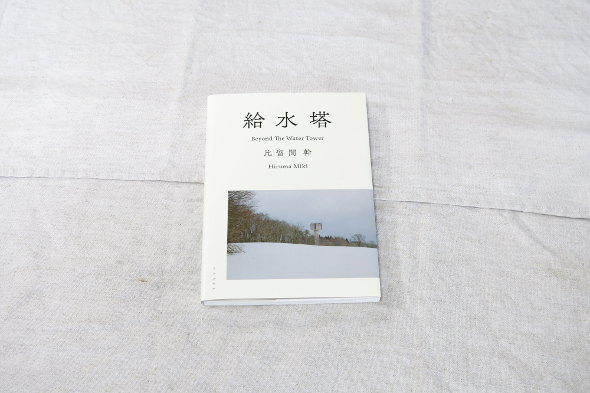
Beyond the water tower has photographs of over sixty Japanese examples of water tower. I don’t know how representative this sample is. (I’m surprised to realize that I’ve paid little attention to water towers — unlike incinerator chimneys, which I notice all the time.) But there’s a wide variety here. The “beyond” of the English title is a mystery: some towers are shown with minimal surroundings, others with more; rather too many are shown in twilight or at night (no such additional drama was needed). If only this degree of imagination went into the design of, say, Japanese schools. (Although the design of water towers pales beside that of playground equipment, which may be to Japan what bus stops are to the spawn of the Soviet Union.)
Disclosure: Nothing. I saw it at Aoyama Book Center (Roppongi), liked it, and bought it.
比留間幹 = Hiruma Miki. 給水塔 (Kyūsuito) = Beyond the water tower. Tokyo: Little, More. ISBN 978-4-89815-419-9. (Captions and text in Japanese only. Samples at Hiruma’s website; the book at its publisher’s website.)
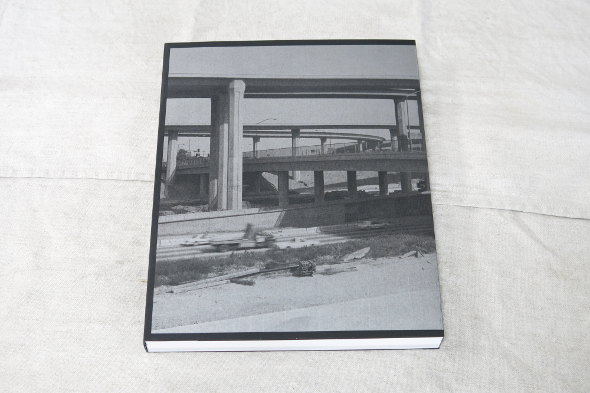
Imperial Courts 1993–2015 has just reached me. Yes it looks good, but I’ve hardly started to digest its content. You’ll have already read about it elsewhere.
Disclosure: Nothing. I liked what Mrs Deane wrote about the photos and what Rob Hornstra and Stanley Wolukau-Wanambwa wrote about the book. (Yes, I was actually swayed by “Best of 2015” lists.) So I ordered a copy from Book of Days.
Dana Lixenberg. Imperial Courts 1993–2015. Amsterdam: Roma. ISBN 9789491843426. (Page in its publisher’s website; exhibition notice; sample photos, photos of scans, essay by Lixenberg here; George Pitts’ review.)
Not much documentary or street stuff above, in large part because I didn’t see much. I suppose Tsutaya has calculated that its customers are more interested in the “young hipsters prancing around naked”, “people with blank expressions standing in front of boring backdrops”, “my tragicomic relationship with my nutty mom/ex/etc”, “my sweet relationship with my wife/husband”, and other genres. Which are welcome to flourish, but which don’t excite me. No, for me the number one boss photobook at Tsutaya remains the facsimile Decisive Moment. (Yes, as Sean O’Hagan says, its photography is outmoded. Time for the modes to change.)
I haven’t seen enough even to pretend that the pile above are the best, even according to my own unfashionable criteria. I’ve only intermittently paid attention to what’s been on the shelves of any bookstore, haven’t once been in any photobookstore outside Tokyo, have read few recommendations, haven’t seen most of what’s on others’ “best of” lists (eg I haven’t seen even one of the eight Teju Cole lists, have (like everyone) been locked out of the library of the Tokyo Museum of Photography, and have been determined to accumulate fewer kilograms than I’d done the previous year. So what you see is all of what I bought. Though I omitted (i) a handful of Café Royal booklets, because once you hear about them from anywhere other than CRB they’re already gone; and (ii) a pedestrian survey, which I seem to have mislaid, of the work of Hamaya Hiroshi, who deserves far better.
One that I didn’t get: The photography in Songbook is great; it can stand without the whimsical and bulky trimmings. (If only it had instead been published by Poursuite!) I might buy a copy of a second, cheapskate edition.
Photobooks of the year that I haven’t seen but hope to: Irina Popova, Welcome to LTP; Kenneth Graves, The home front; Stephan Vanfleteren, Charleroi: Il est clair que le gris est noir; Paolo Woods and Gabriele Galimberti, The heavens: Annual report; David Solomons, Up west.
Photobooks of 2016 I’m most looking forward to: Chris Killip, In flagrante two; Rosalind Fox Solomon, Got to go; Jason Eskenazi, The black garden; plus what I haven’t heard of and can’t even start to imagine.
Photobook I bought most recently: Rolf Reiner Maria Borchard, Riga (1999): a staid but handsome portrait of that city, bought at the Iidabashi branch of Book Off on 22 December for just ¥200 (xe.com says €1.52).
Best non-photo book recommended to me this year by any photographer: Richard McGuire, Here.
Want other, better informed lists? Here’s a list of links to them. (How many will there be? There were at least 22 for 2011, 56 for 2012, 87 for 2013 and 58 for 2014.) For another view of mostly Japanese books, see John Sypal’s list.
If you take this stuff seriously, try this; and if like me you don’t, try this.
Sputniks need you
Posted: 17/01/2015 Filed under: credit cards accepted | Tags: Adam Pańczuk, Agnieszka Rayss, Jan Brykczyński, Michał Łuczak, Rafał Milach, Sputnik Photos 1 CommentHaving photographed Ukraine (U and Black Sea), Belarus (Stand BY and The winners) and Iceland (IS (not) and In the car), the intrepid Sputniks contemplate the creation of stannotypes of Kazakhstan, Uzbekistan, Turkmenistan, Tajikistan and Kyrgyzstan. Here’s their vimeo. And here’s their Indiegogo.
Yes, they need our moolah. I’ve already handed over some of mine; how about some of yours? We’ll all get some swag plus a glowing feeling. So pull out that smoking hot credit card and do the right thing, please.
that criminal investigation, again (again)
Posted: 28/12/2014 Filed under: Books | Tags: Watabe Yūkichi 3 CommentsWatabe Yūkichi spent twenty days in 1958 with a couple of policemen — Mukōda Tsutomu and his younger sidekick Midorikawa Katsumi — working on a murder investigation. You’ve probably heard the story (here): after some photographs from the series were published in 1958, the series was mostly forgotten in Japan (and Watabe’s work seemed entirely unknown elsewhere) until Parisian publication in 2011 of A criminal investigation. The book went down very well. In retrospect I’m surprised by the coolness of the welcome that I gave to it; I was better disposed to a different collection, 張り込み日記 (Harikomi nikki) = Stakeout diary, in 2013. Both books went out of print and have been reprinted at least once.
And now there’s a third collection, confusingly again titled 張り込み日記 (Harikomi nikki). I’ll call it Nikki 2.
I can’t think of any precedent for this in the wild, wacky world of photobook publishing. But publishing economics (and copyright issues) aside, let’s look at the book.
Here’s its front cover (“Konipan SS”), lying on top of the original Harikomi nikki = Stakeout diary, which I’ll call Diary.
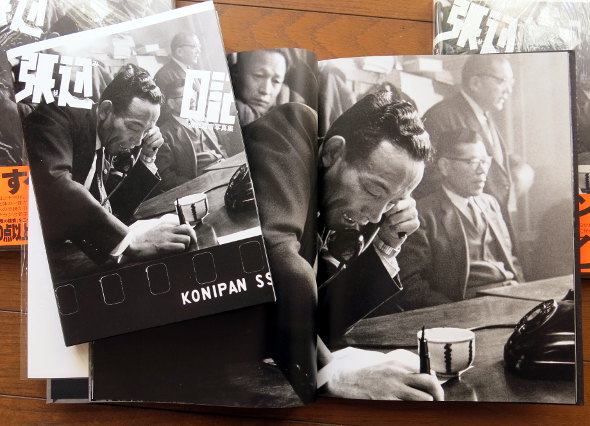
Here’s a spread from Nikki 2, on top of the corresponding spread from Diary.
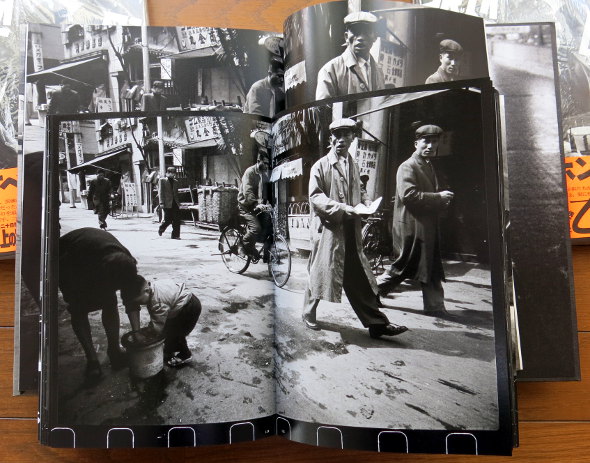
A bit more interesting: a spread from Nikki 2, on top of the corresponding spread from Diary, the two of course being from different frames.
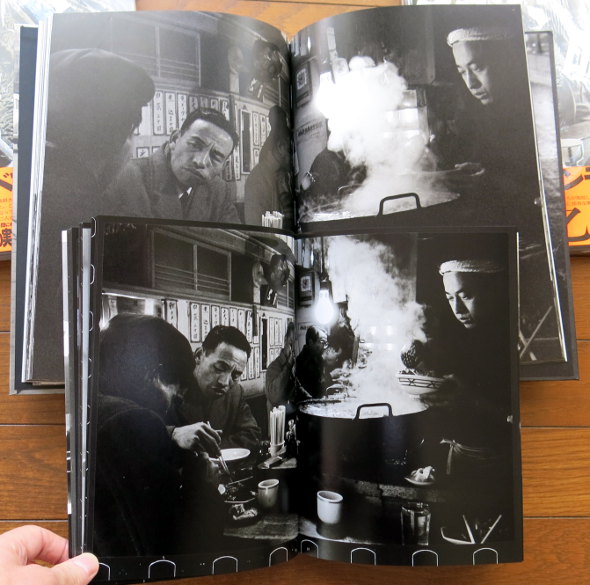
Yes, damaged by the gutter. But plenty of photos aren’t affected by the gutter:
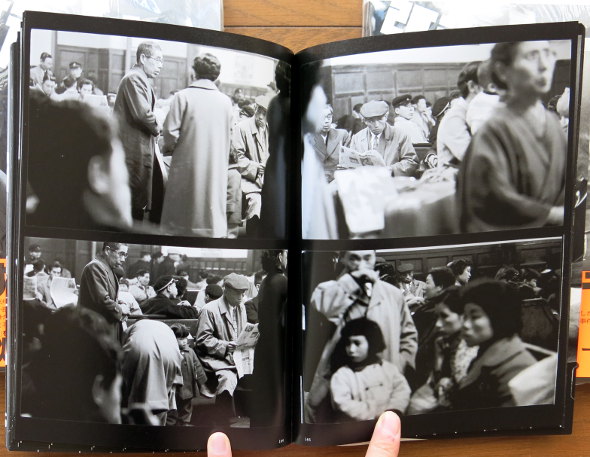
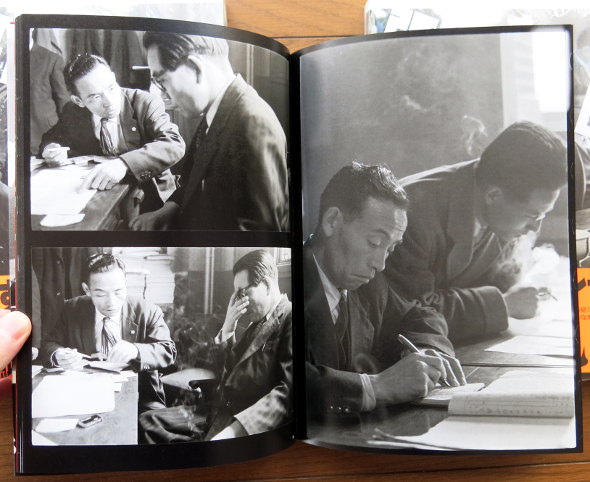

The book’s publisher is Nanaroku-sha, which shifts large quantities of easy viewing. Nanaroku-sha claims (here) that the book has over 140 photos, and gives conspicuous credit to editorial input from Otsu Ichi, a writer easy reading. It augurs badly. But it works out well. When I look at page after page of material by other photographers that’s primarily praised for its “atmosphere”, I tend to yearn for (in)decisive moments or whatever and get bored; here, not. The more of Watabe’s photos, the more fascinating.
The book is compact, the printing (by Sun M Color) is excellent, and even with tax included it’s under three thousand yen.
渡部雄吉 (Watabe Yūkichi). 『張り込み日記』 (Harikomi nikki). Tokyo: ナナロク社 (Nanaroku-sha), 2014. ISBN 978-4-904292-52-5.
I can’t find any company whose packing I’d trust that is offering to sell this book to people who don’t happen to (i) be able to read Japanese or (ii) live in Japan. But Japan Exposures does say “if you can’t find what you’re looking for, by all means get in touch”.
books for So Books
Posted: 28/08/2014 Filed under: Uncategorized | Tags: bookshops 1 CommentOh dear, hibernation lengthened into humid aestivation. True, I did go out on my bike, but only at a hypometabolic rate. And I did once briefly emerge for a top secret editorial session (not) for 10×10 Japanese photobooks.
Of course, even aggravated by the high percentage among new photobooks of “understated contemplative color […] Blank-gazed portraits, nondescript no-man’s areas, poignant vistas, etc” (zzz), a hypometabolic interlude didn’t stop additional photobooks from adding height to the piles on the floor of Microcord Mansions. Just last week: Dutch eyes. A huge and superb book — and one that, upon unwrapping, I immediately realized I’d already acquired. How could anyone accidentally buy a second copy of a book like this? Clearly, something was very wrong.
All in all I was very receptive to news from Mr Saito of an appeal for books (and prints) to help the excellent So Books get back on its feet after a destructive and expensive flood two months ago. So Books (here) is one of my favourite places in Tokyo, and clearly it needed some of my photobooks more than I did.
There’s going to be a sale of donated books and prints on 13–14 September. Just two days. So I dug around for books that I thought would go fast. The final selection for So-aid:
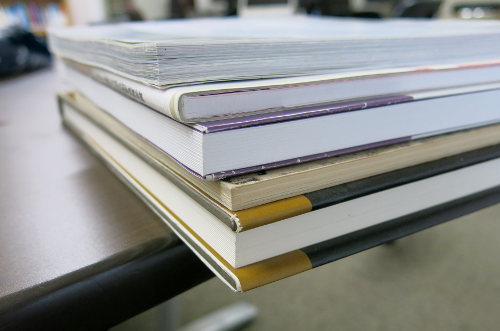
(The second one up is by some Swiss bloke that Parr ’n’ Badger natter on about quite a bit. Next one up is by a Japanese photographer who’ll forever be beneath their attention; that’s their loss and our gain. The other three induce intermediate degrees of salivation among photobookies.)
Yesterday I bagged the five and staggered under their weight to Poetic Scape, whose proprietor is generously storing all this stuff and hosting the two-day blowout sale. And who treated me to a glass of fizzy wine. As yet another bonus I could see a little show there, notably photos by Iinuma Tamami, whose series Salute, Mr Bruno Taut I like a lot.
Got any good photobooks you don’t actually need? Then send or take them to Poetic Scape. This is at Nakameguro 4-4-10, Meguro-ku (map); it’s open Wed, 16:00–22:00; Thu–Sun, 13:00–19:00.
By mid-September of course we’ll all need a topping-up of photobooks (and prints); so, cash in hand and equipped with eco-bags and backpacks, let’s all go along to Poetic Scape on 13–14 September. (Just among this year’s new books, I’d spring for a copy of Them or Home among black hills, if anyone would care to donate either.)
Oka Tomoyuki’s spoil
Posted: 07/01/2014 Filed under: Books | Tags: black and white photobooks, Oka Tomoyuki, photobooks from Japan Leave a comment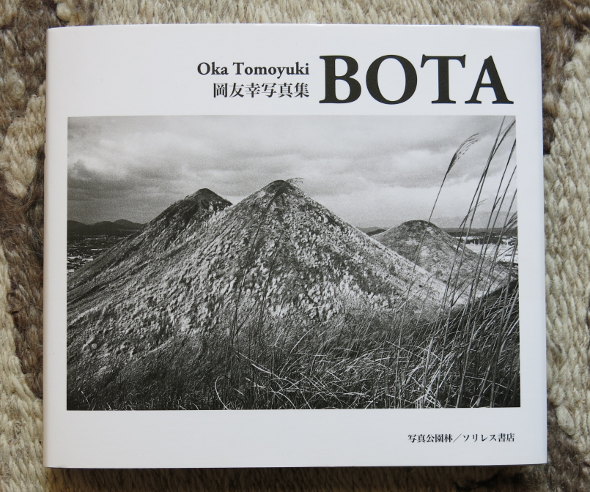
A botayama is a slag heap, so bota is slag — but no, Wikipedia says that the content of a “slag heap” isn’t slag; the whole thing is more properly a “spoil tip” and its content is spoil.
After explaining the word bota, the front of the obi says 石炭から石油へ、そして電子力へと移り変わってきた時代と、そこに暮らす人々をボタ山は静かに映し出す; or something like “At a time when coal has changed to oil and then to nuclear energy, spoil tips reflect the people who live there.”
The very first photo (like the very last) of this new book by Oka Tomoyuki is surely of coal. And there follow views of spoil tips. There are some dilapidated buildings, people walking over what might be spoil tips with sparsely added topsoil, people walking along country lanes, thicker vegetation, people taking naps, details of gardens, portraits. Some of the same people reoccur — surely these must be the photographer’s parents, this his brother. . . .
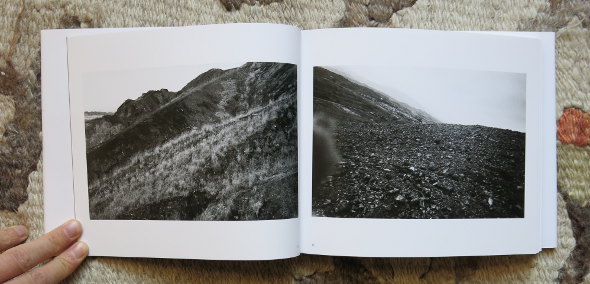
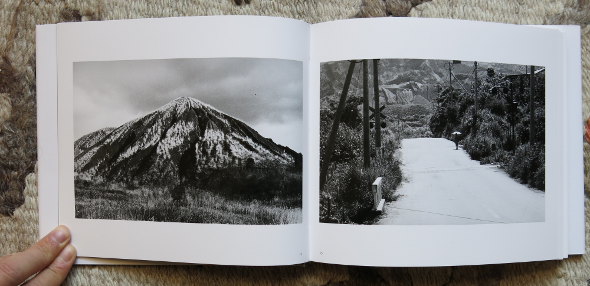
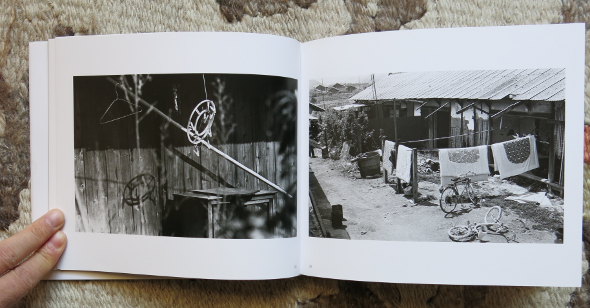
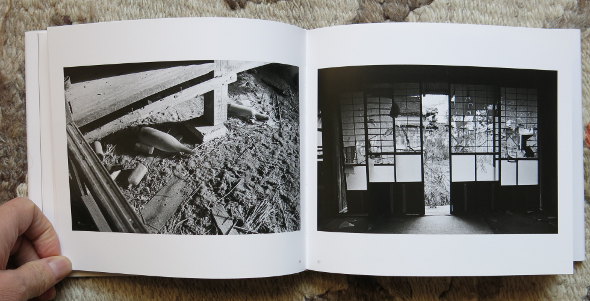
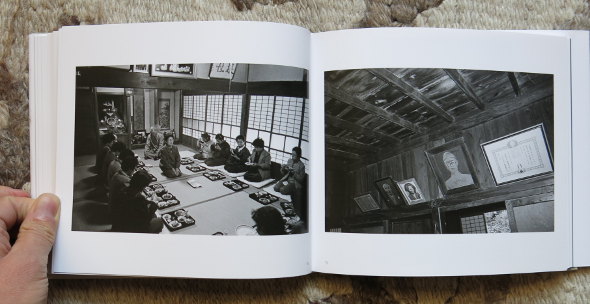
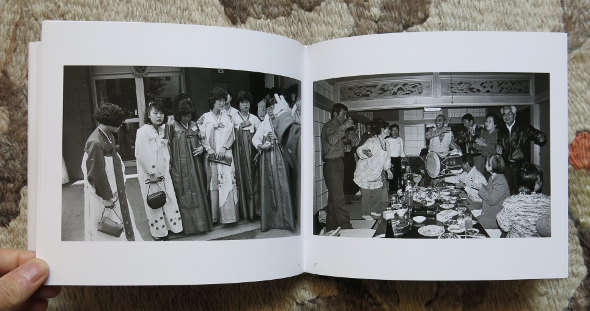
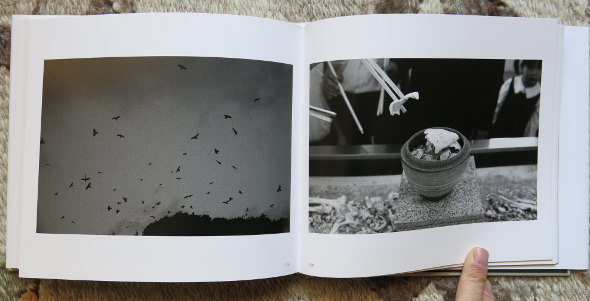
This hardback has 140 photos or so, each numbered. On a double-page spread in the back is a two-page memo of which photo is what — or rather, where and when. A typical example:
22 桂川町天道 1980
meaning that plate 22 is of a photo taken in Tentō, Keisen in 1980. And we’re told that the prefecture is Fukuoka when (as here) not otherwise noted. There’s never any explanation of what it is that we see, let alone any comment on it — just where and when.
But at least we have the placenames. A first glance suggests that most are in Fukuoka and the rest elsewhere in Kyūshū. Not so: a bunch of photos are from the coalmining area of Hokkaidō; and some are from such obviously coal-free areas as Okinawa and Tokyo. So instead the book seems to be a collection of whatever was important to Oka in almost forty years of photography, notably life above or near a coalfield that hasn’t been worked for over thirty years but was still being mined when he started out. It’s not in chronological order, and as constantly looking up the years of photos is tiresome the reader stops — or anyway, I stopped bothering, and instead did some more thinking for myself, noticing changing shapes of car, changing fashions and more before looking in the back.
Thanks to its format — 19 × 22 cm (and thus close to that of The Americans) — this intriguing book is very portable and I’ve enjoyed reading it on the train.
Oka Tomoyuki (岡 友幸). Bota. Tokyo: Shashin Kōen-rin, 2013. ISBN 978-4-9906656-4-7
Shashin Kōen-rin (写真公園林) means “photograph park wood” (“wood” as in “this dark wood“). It’s run by the photographer Hama Noboru (perhaps best known for his giant book Vacant land 1989). On the rear of the book, the obi proudly lists two other books from the same publisher: one (by Hama) was published in 1990 and the other (by Ōshima Hiroshi) in 1987. Sales are via Sot l’y laisse (ソリレス書店), which hasn’t yet got around to mentioning Bota on its Facebook page. The book is distributed in Japan by Tsubame (ツバメ出版流通) (whose name means “swallow”).
Sales page at Nite-sha; sales page at HMV.
The only biographical info I can find about Oka is on this PDF from Tsubame about the book. My translation:
Photographer. Lives in Fukuoka city. Participated in the founding and running of Photo Gallery PUT (Shinjuku, Tokyo), 1976–79. From 1984 to 1986, engaged in the editing and production of the ten-volume Shashin-man’yō-roku Chikuhō (写真万葉録・筑豊) [overliterally, “Ten-thousand-photograph record of Chikuhō“]. Author of Ueno Eishin no shōzō (上野英信の肖像) [“Portrait of Ueno Eishin“] (1989), Boku no Ajia chizu (ぼくのアジア地図) [“My map of Asia”] (1995), the five-volume digital photo collection Asia in my eyes, and (jointly) of Kaze no michizure (風の道づれ) [“Companion(s) of the wind”] (1991). Author’s web page “Gallery 36EX”: http://www.36ex.com.
— though 36ex.com doesn’t seem to mention the book or even its photographer.
Japan’s coalmines have given rise to a great amount of rewarding photography and art (as well as film and more). The best one-volume introduction I know of is the hefty 2009 exhibition catalogue の美術・写真・グラフィック・映画 ‘文化’資源としての展 (“Yama” no bijutsu, shashin, gurafikku, eiga: ‘Bunka’ shigen toshite no “tankō” ten) = The coal mine as cultural resource: Art/photography/graphic arts/film of Japanese coal mines (OCLC 525397491, mostly in Japanese only, but partly also in English translation). If the “Superflat” drivel currently feted by Fine Art idiocracy has you nodding off, wake up with Yamamoto Sakubei, Senda Umeji and more.
Almost totally irrelevant to anything above, but demanding a link all the same: Tokyo Photo Travel Guide part 2: Shinjuku Camera Shop walk. Excellent! Come to Japan and bring your monies. Somewhere in that same area thirty-something years ago was Photo Gallery PUT.
no vacuum
Posted: 24/12/2013 Filed under: Books | Tags: Abe Jun, photobooks from Japan Leave a commentThe way to keep up with Osaka’s Vacuum Press is via its website. Obvious but wrong: while the website sleeps, Vacuum is pressing out more books. Two are Noguchi Yasuko, The noon moon; and Abe Jun, 2001. I haven’t yet seen either, but both are described at Japan Exposures.
yet more opportunities for spending your cash
Posted: 24/12/2013 Filed under: Uncategorized | Tags: bookshops, Suda Issei, Tsutaya Leave a commentA belated discovery that the Daikan’yama branch of Tsutaya is open from 7 a.m. had me heading there (rather later) this morning, because why not. I emerged after no mammoth expense; in part because I missed (or perhaps because they didn’t have) Suda Issei’s latest: the pair of Tokyokei (here at its publisher, here at Nite-sha) and The journey to Osorezan (here at Nite-sha).
Later I might get one or even both; because after all I’m not yet bankrupt and the price of a copy of every one of these Japanese/Taiwanese Suda books from the last couple of years adds up to less than that of one sixth (the Suda part) of this plutocrat pack. And the new pair probably have photos that are a lot more rewarding than the average in the pluto-pak, too; though the latter does come “on [Nazraeli’s] exclusive heavyweight Japanese paper and bound in Japanese cloth”. (Me, I’m less interested in the nationality of binding material than in the degree of welcome it provides for mildew spores.)
So anyway, Daikan’yama Tsutaya. This store has new copies of She dances on Jackson (whose cover makes it the perfect complement to Watanave’s Hito), of the Super Labo zine Wild flowers, of Stakeout diary, and of other much-discussed books that I’ve read are out of stock elsewhere.
How can this be? I’d guess because this branch of Tsutaya is designed to “navigate the lifestyles” — really! that’s what they say — of the moins de vingt dents: people sufficiently sprightly to be cruising for photobooks while the youthful and civilized are still having breakfast, but lacking the energy to have gone to the vernissages months earlier and picked up the free booze and tips on who’s hot and who’s not.
swell photobooks of 2013
Posted: 14/12/2013 Filed under: Books | Tags: "best of" lists, Arimoto Shinya, Kurata Seiji, Onaka Kōji, photobooks from Japan, Suda Issei, Watabe Yūkichi 3 CommentsApproaching the end of another year: it’s the season for photobooks roasting on an open fire, and lots more mutual encouragement to acquire more stuff and make the year’s consumption more conspicuous. I’m tempted to do a world survey, but I haven’t seen enough of what my fellow bloggers prattle about, let alone of the many more books that largely go unmentioned but that sound interesting (example). So I’ll do a _Valerian and look at Japan and not sekai (as the rest of the world is called hereabouts).
I thought that Abe Jun’s Black and white notebook 2 came out this year, but its colophon tells me December ’12. So that’s out. I solemnly swear that all the below are from 2013, honest. (Except for one that might be older than you are, but this is clearly so identified.)
Onaka Kōji, Lucky cat
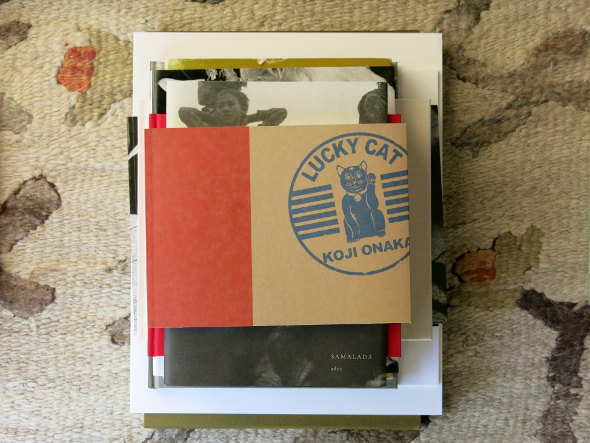

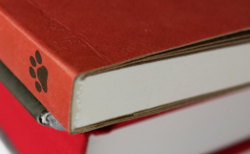
The lucky cat of the title is the maneki-neko; but fear not, there are only two of these in the book. Both are distinctly old and worn, as is just about everything else depicted in this collection of musty and rusty nooks of Japan, each somehow with its attractions.
Plenty of photos of this here at Onaka’s site, here at atsushisaito’s, and here at Josef Chladek’s. Here’s a video flip-through of the book.
Onaka Kōji (尾仲浩二). Lucky cat. Matatabi Library. No ISBN. I think “Matatabi Library” means Onaka. (Trivia lovers: matatabi means this.) Anyway, the book is available from the man himself (rather stiff postage charges) as well as booksellers.
(For this and the other books below, potentially helpful booksellers are linked to at the bottom of this post.)
Adou, Samalada

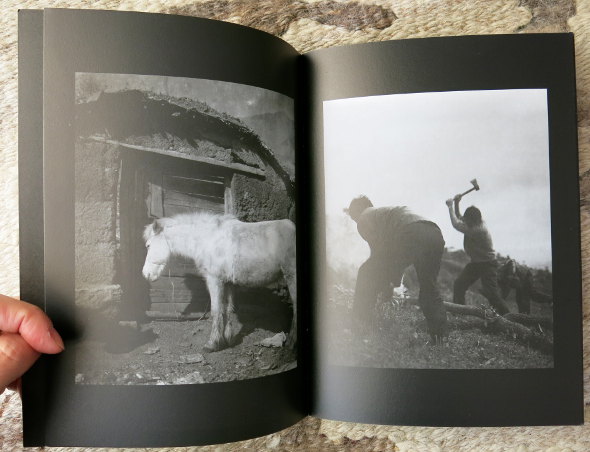
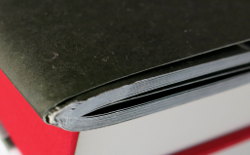
Adou was a new (Chinese) name to me when I saw a show of his work this year at Zen Foto Gallery (Roppongi). The prints were big and murky (neither of which normally attracts me); S(h)amalada (here) looked bleak, but the photographs were compelling all the same.
You can see them on Adou’s site and also here at M97 Gallery (Shanghai).
Adou (阿斗). Samalada = 沙馬拉達. Zen Foto Gallery. ISBN 978-4-905453-28-4.
The booklet (shown above) from Zen seems to be at least the third major publication of these photos: they have also constituted one volume out of the five of a boxed set, Outward expressions, inward reflections (外象, here); and earlier this year the larger half of a book, Adou & Samalada (阿斗 · 沙马拉达, here). I haven’t seen the former, but the printing in the latter is so different from that in the Zen booklet that somebody (and not only a collector fetishist) might actually want both. If (more sensibly) you want just one, perhaps get the Zen version if you’re in Japan, one of the two Chinese versions if you’re in China, and compare airmail charges etc if you’re elsewhere.
Suda Issei, Early works 1970–1975


 Here’s one for you rich people! Yes, over two hundred photos taken by Suda in his early thirties (and thus allowing for at least one volume of very early works). A lot of these appeared in photo magazines at the time. So let’s correct the above: this horribly expensive book is for the middle-income, the rich being able to afford places large enough to house complete runs of 1970s’ Asahi Camera and its rivals. Some is rather “street”, a lot is close to Fūshi kaden. Most is 35mm (or anyway isn’t square). Not every plate is of a five-star photo, but enough are, and the reproduction is excellent.
Here’s one for you rich people! Yes, over two hundred photos taken by Suda in his early thirties (and thus allowing for at least one volume of very early works). A lot of these appeared in photo magazines at the time. So let’s correct the above: this horribly expensive book is for the middle-income, the rich being able to afford places large enough to house complete runs of 1970s’ Asahi Camera and its rivals. Some is rather “street”, a lot is close to Fūshi kaden. Most is 35mm (or anyway isn’t square). Not every plate is of a five-star photo, but enough are, and the reproduction is excellent.
As if there weren’t already enough gimmickry in the wacky world of photobooks, this one comes with a choice of five cover photos.
Suda Issei (須田一政). Early works 1970–1975. Akio Nagasawa. No ISBN.
The same publisher recently decided that its Fūshi kaden wasn’t expensive enough already, and raised the price by 50%. That might happen with this book too.
Suda Issei, Fragments of calm
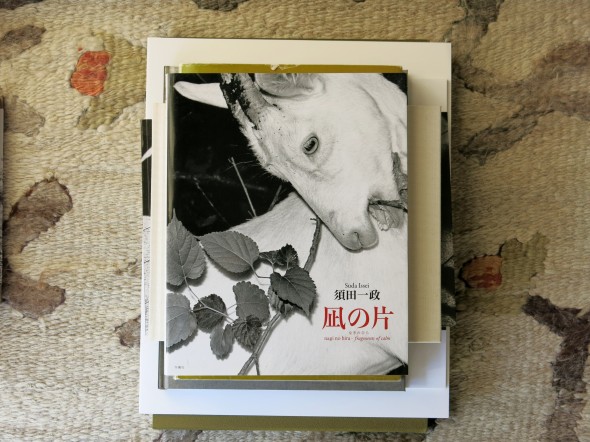

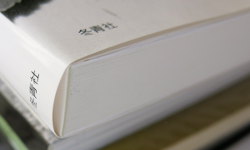 The Tokyo Metropolitan Museum of Photography is of course a wonderful institution but it has recently taken to devoting an entire floor to this or that exhibition of overly reproduced or modishly boring photos. But now and again it has an excellent exhibition of the first-rate; and this year’s big Suda show was one. (With a modest entry price too.)
The Tokyo Metropolitan Museum of Photography is of course a wonderful institution but it has recently taken to devoting an entire floor to this or that exhibition of overly reproduced or modishly boring photos. But now and again it has an excellent exhibition of the first-rate; and this year’s big Suda show was one. (With a modest entry price too.)
And here’s the catalogue. The idea seems to have been that of a tolerably good package of decently sized plates, held down to a very palatable price. So many pages are rather cramped, the printing quality is distinctly twentieth-century, and the result would never win any photobook award. Don’t complain, because you get decent reproductions of over two hundred good photos at a keen price.
(For those interested in these matters: Suda seems to have signed hundreds if not thousands of copies, which, as is normal in Japan, go for the list price. Indeed, a recent book by Suda that doesn’t have his signature might be a “collectibly” rare variant.)
Here’s a video flip-through of the book.
Suda Issei (須田一政). Fragments of calm = 凪の片. Tōseisha. ISBN 978-4-88773-145-5.
Hara Yoshiichi, Tokoyo no mushi
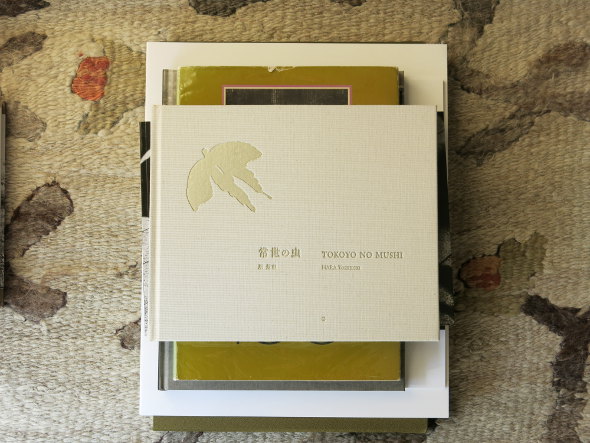
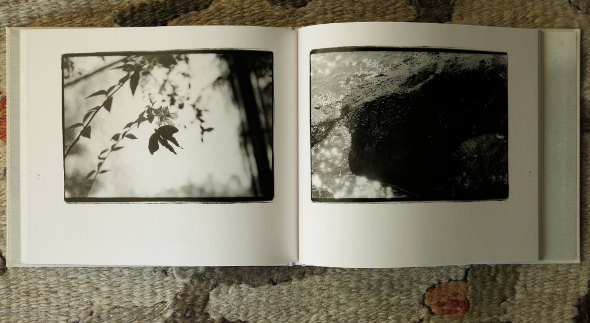
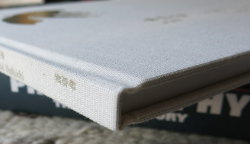 The title means something like “eternal insects” or “insects from the realm of the dead”, and a prefatory note by Hara says he’s heard stories that after death people are transformed into insects. There follow photos incorporating insects, photos of (a non-entomologist human’s idea of) an insect’s view of the human world, photos alluding to birth and to death, photos of models of the human world at a (large) insect’s scale, and more. The religious may make sense of this; I just enjoy the results in my atheistic way.
The title means something like “eternal insects” or “insects from the realm of the dead”, and a prefatory note by Hara says he’s heard stories that after death people are transformed into insects. There follow photos incorporating insects, photos of (a non-entomologist human’s idea of) an insect’s view of the human world, photos alluding to birth and to death, photos of models of the human world at a (large) insect’s scale, and more. The religious may make sense of this; I just enjoy the results in my atheistic way.
There are plenty of photos of this book here on Josef Chladek’s site and here on atsushisaito’s.
Hara Yoshiichi (原芳市). Tokoyo no mushi = 常世の虫. Sōkyūsha. No ISBN.
Nuno Moreira, State of mind

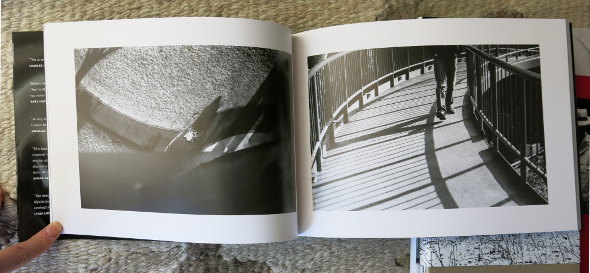
 This book is going to puzzle whichever poor librarian is the first to provide Worldcat with a record for it: no publisher is specified, let alone place of publication. Actually it’s published by its creator, who (mostly) lives in Tokyo; so despite its Portuguese ISBN it’s at least as Japanese as it is Portuguese or anything else.
This book is going to puzzle whichever poor librarian is the first to provide Worldcat with a record for it: no publisher is specified, let alone place of publication. Actually it’s published by its creator, who (mostly) lives in Tokyo; so despite its Portuguese ISBN it’s at least as Japanese as it is Portuguese or anything else.
It’s a collection of “solitary moments of disconnection” (in the photographer’s words), or perhaps of indecisive moments (not his words). We see individuals thinking, individuals not thinking, scenes likely to start one thinking — yes, it’s free-ranging. There’s even the occasional crowd, though the individual seems in a pocket of space within it. And many pleasing plays of light and shadow.
Many photos from the book here; and here’s a video flip-through of the book.
The printing could be better, but it does the job. (Certainly the book makes a refreshing change from the piles of exquisitely printed books of boring photos.)
Nuno Moreira. State of mind. Self-published. ISBN 978-989-20-4151-3. Available from the man himself.
Suda Issei, Waga Tōkyō 100

Looking a bit tired, with its dated cover design? Well yes — it’s over thirty years old.
And yes, it’s Suda again. The title can be loosely translated as “a hundred views of my Tokyo”. More square B/W, from shortly after what’s in Fūshi kaden, and similar to that and almost as good. The book shown above is printed well for its time, there are seemingly thousands of copies available, and (other than from the dealers with the slickest websites) these are cheap.
Or so I had thought. But I now realize that copies now cost about three times as much as they did just three years or so ago when I bought mine. (At hermanos Maggs, ten times as much.)
And so it makes sense for a new edition to come out. But this is a bit on the pricey side. If I lost my copy of the old one I don’t know which edition I’d replace it with. For those who don’t happen to be in Japan, a copy of the new edition (details below) would be easier to obtain than a reasonably priced copy of the old one.
The new edition is a kind of hardback/paperback hybrid. (Unkindly, it’s like a hardback whose front hinge has been neatly sliced through.) It’s shorn of a lot of the (Japanese) text of the first edition, but it has some new text in Japanese and English. And it’s well printed. The plates are (trivially) smaller than those in the original. Although the sequence of plates is different, I think that the same hundred are used in both.
Suda Issei (須田一政). Waga Tokyo 100 = わが東京100. Zen Foto Gallery. ISBN 9784905453314 (I think). The price is being held down for some time, whereupon it will jump 25% or so (to about half of the current price of Early works 1970–1975).
Watabe Yūkichi, Stakeout diary


 You know the story, or bits of it: For twenty days in 1958 a youngish photographer was allowed to photograph two cops hunting for a suspect in a grisly murder; some of the resulting photographs were published in a magazine in 1958, they were then largely forgotten; somebody bought prints half a century later and turned them into the only non-Japanese book by this “unknown” photographer; the book was much feted outside Japan (and an unusual and expensive import within).
You know the story, or bits of it: For twenty days in 1958 a youngish photographer was allowed to photograph two cops hunting for a suspect in a grisly murder; some of the resulting photographs were published in a magazine in 1958, they were then largely forgotten; somebody bought prints half a century later and turned them into the only non-Japanese book by this “unknown” photographer; the book was much feted outside Japan (and an unusual and expensive import within).
Well, here’s a Japanese edition, from prints freshly made by Murakoshi Toshiya; and from a brand new publisher, Roshin Books. It has a larger format than A criminal investigation and contains photos that aren’t in that; and the package doesn’t try so hard to be remarkable but I prefer it. “Landscape” photos are either broken across the gutter or squeezed into half a page; I’d have been happier if they’d been rotated to fill the single page. But a large percentage are “portrait”, and this is a fine book.
Plenty of photos of this are here at atsushisaito’s site, and here’s a video flip-through.
This book too has front cover variants. All variants of the regular version are sold out (at Roshin, if not necessarily at retailers), but Roshin still has copies of the version that comes with a print.
Watabe Yūkichi (渡部雄吉). Stakeout diary = 張り込み日記. Roshin Books. ISBN 978-4-9907230-0-2.
I’m looking forward to the appearance in January of Roshin’s second book. (And I wonder if there’ll be a second book from Plump Worm Factory, publisher of Murakoshi’s Prayer & bark.)
Kai Keijirō, Shrove Tuesday


 The photos here are alarming. They’re obviously of somewhere in Britain. There are many young and middle-aged heads glaring, gasping for breath, or just looking lost; they’re all male, many are shaven, they’re all “white”. Yet there are no flags of Ingerland and so it can’t be the EDL.
The photos here are alarming. They’re obviously of somewhere in Britain. There are many young and middle-aged heads glaring, gasping for breath, or just looking lost; they’re all male, many are shaven, they’re all “white”. Yet there are no flags of Ingerland and so it can’t be the EDL.
It’s sport(s), but far from what you might see on the telly. It is instead the Shrovetide football match of Ashbourne (Derbyshire): one of the most physical of Britain’s quaint provincial customs. Just good testosterone-powered fun! Somewhere in the middle of all this, there must be a ball — though since most of the players themselves are just blindly following other players (and trying to infer who’s on which side; there are no uniforms), perhaps there isn’t after all and instead it’s far away.
All very exciting, and I hope that Kai follows it up with more revelations of the exotic occident (but pauses before his camera or head collides with a boot).
Kai Keijirō (甲斐啓二郎). Shrove Tuesday. Totem Pole Photo Gallery. No ISBN. Available from TPPG if you go there in person.
Arimoto Shinya, Ariphoto selection vol. 4
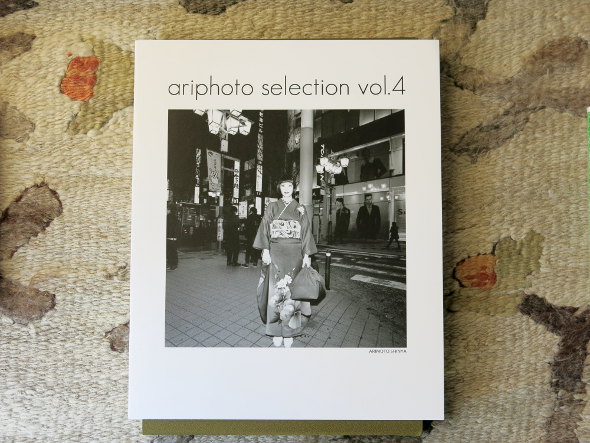
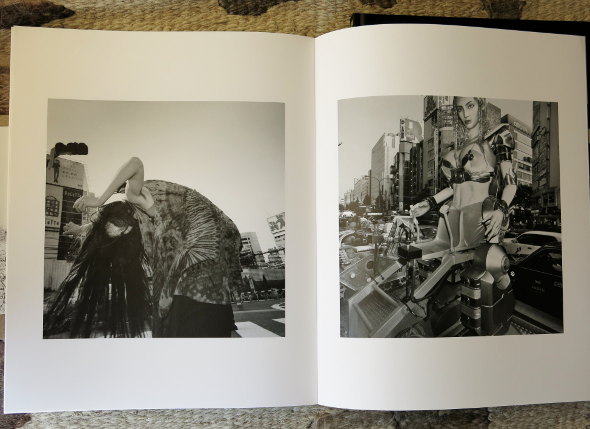
 The fourth fascicle of . . . I don’t quite know what, after the third (of Tibet) showed I was wrong to think it was Tokyo.
The fourth fascicle of . . . I don’t quite know what, after the third (of Tibet) showed I was wrong to think it was Tokyo.
They’re probably not fascicles at all, and should be enjoyed independently. And enjoyable they are. They’re “street”, street portraits, things seen in streets. In the first three photos in vol. 4, an elderly, heavily bejewelled gent fishes change from that relic of the last century, a payphone; a contortionist performs in mufti, no, she’s just a normal girl trying to shake a tiny stone out of her boot; a young transsexual happily displays her new breasts to a friend (out in the street, in daylight). True, there aren’t many more photos, but each is big and well printed.
Arimoto Shinya (有元伸也). Ariphoto selection vol. 4. Totem Pole Photo Gallery. No ISBN. Available from TPPG if you go there in person, or from the man himself over the interweb. Or from PH, which still seems to have copies of vol. 3 (out of stock elsewhere).
Kurata Seiji, Flash up

Such an opulent slipcase. It looks like a lot of the big photobooks from the sixties that gather dust in Tokyo’s used bookshops: you see a familiar name on the spine — Iwamiya or Midorikawa, perhaps — and look inside to discover that it’s all about Japanese gardens, is in muddy colours, is deadly dull, and cost 38,000 yen (of 1960s money) when new. (Did companies buy them up to hand them out as trophies?)
But a gaudy kind of opulence is appropriate here. Cabaret packaging, indeed (preferably reeking of old cigarette smoke). Because it’s for:

Yes, this is a long overdue second edition of a boss photobook. (Don’t recognize the title? Check your Parr ’n’ Badger, I:305.)
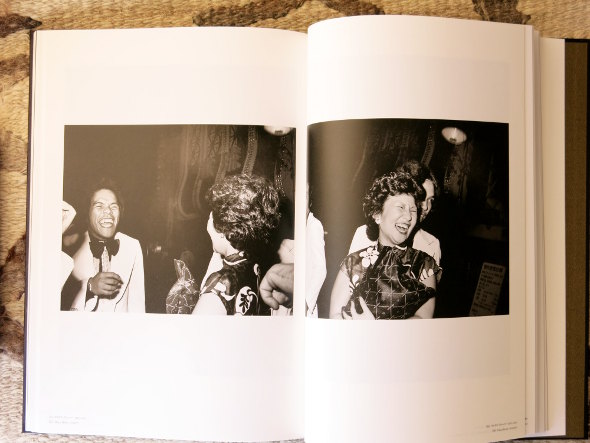





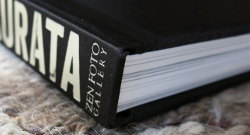 No blurring or other Provoke-ative devices here; instead, it’s a 6×7 or 6×9 and flashgun used fluently in Weegee/Moriyama territory, delivering more immediacy and happy surprises than most photographers can manage outdoors in daylight. The most Weegee-like photos are gruesome but the others are among the most enjoyable photos anywhere.
No blurring or other Provoke-ative devices here; instead, it’s a 6×7 or 6×9 and flashgun used fluently in Weegee/Moriyama territory, delivering more immediacy and happy surprises than most photographers can manage outdoors in daylight. The most Weegee-like photos are gruesome but the others are among the most enjoyable photos anywhere.
And more prints, and bigger ones, than you’ll find in the first edition. Which anyway costs about twice as much as this second one costs — which is a lot, but justifiably so. (NB the new edition is so big and heavy that postage could be considerable.)
Plenty of photos of this here at atsushisaito’s blog.
Kurata Seiji (倉田精二). Flash up. Zen Foto Gallery. No ISBN.
Plus special pats on the back for three books that I didn’t buy and therefore can’t plonk on the rug in front of my camera:
Watanave Kazuki, Hito. The title means “people” (or “person”), and the book follows pigs from happy life to merchandise: in colour, with all that this entails. It’s neither sensationalist nor sparing, and comes with thoughtful afterwords (in English as well as Japanese) by two of the men whose work is depicted. Here it is at atsushisaito’s blog. An admirable book, one I’d recommend for any library, but (sorry) not one I’d often want to look at, and so space constraints rule it out.
Watanave (Watanabe) Kazuki (渡辺一城), Hito (人). 4×5 Shi no go. ISBN 9784990559816. According to a page within the website of the publisher (a group or company of four photographers), the address to ask about it is contact [at] shinogo.com
Kōriyama Sōichirō, Fukushima. Straight but thoughtful documentary photography of the effect (social and only indirectly medical) of radiation in Fukushima. Slim, but well done, informative, excellently printed, and modestly priced. I’m not getting a copy only because I OD’d on similar (if mostly inferior) books last year, and because plenty of libraries here should have it.
郡山総一郎, Fukushima × フクシマ × 福島. 新日本出版社. ISBN 978-4-406-05673-1.
I don’t remember Kōriyama’s book as providing English captions, but there are hints here that it does (and that it has an alternative title, Fukushima black rain).
Shiga Lieko, Rasen kaigan: Album. The ghost of Nickolas Muray appears to the young Naitō Masatoshi, prods him to watch Eraserhead and gives him some bricks of infrared Ektachrome. Or something like that. This book, which you’ll have read about already, has some fascinating photos (the ash or snow covering the car interior, the glittering disposable plates, etc). I suppose it’s something like a feature film on paper . . . but a feature film fits handily into a DVD (or of course a few square nanometres of a hard drive) whereas this is a considerable slab of dead tree. And while I might flick through the (many) photos of stones, I wouldn’t want to examine them. Also, when I open the book wide to get a good view of the photos across double-page spreads, the spine makes an ominous cracking sound. But yes, the best of it is very good, so I look forward to Shiga’s Greatest hits.
There are some patterns here:
- Every one of the book(let)s above is published in Tokyo (except perhaps Lucky cat). Seigensha and (I think) Foil are based in Kyoto, but recently haven’t excited me. Vacuum Press (Osaka) has been quiet, Mole (Hakodate) is either dead or long dormant, and I haven’t noticed anything new like Kojima Ichiro photographs (nominally published in Tokyo but really a production of Aomori).
- Mostly B/W. This is odd: Most of the new non-Japanese books that interest me are colour.
- Overwhelmingly by men. Very bizarre, as plenty of the new non-Japanese books that interest me are by women.
- Mostly by old geezers (if not necessarily old when they took the photos). Really sad, this. I do see some excellent little shows by young photographers.
- Skewed toward one photographer, Suda. If any septuagenarian Japanese photographer merited a raise in exposure, it was him. I don’t begrudge him it at all. Still, it’s amusing to see the star-making system in action. (And of course I’ve added my unimportant croaks to the chorus.) This year there’ve also been two other books by Suda that I haven’t mentioned above, and in the next few weeks there’ll be Tokyokei and, I believe, one more. Good! But . . . enough for now? Attention Roland Angst: Could you now please (re)discover Nagano Shigeichi?
Again inspired by _Valerian, some (more) words on books I didn’t buy:
Araki seems to put out a new book every couple of weeks, and I only look into a copy in a bookshop if its cover is both unfamiliar and arresting. Some I didn’t notice at all. Shi-shōsetsu (死小説, perhaps also titled Death novel) would have been one of these. I normally don’t bother looking at anything by Moriyama unless somebody is particularly enthusiastic about it, but View from the laboratory (実験室からの眺め, on Niépce) looks interesting and I look forward to examining it. Kawauchi’s Ametsuchi seems to have some good material, but I wasn’t much tempted even by a pile of half-price copies (here) of the Japanese edition, in part because this shares the perverse design of the Aperture version.
And then there are — I infer from word of Einmal ist keinmal — more books whose existence I haven’t even noticed.
Plus my taste is probably defective.
If you’re in Japan, you’ll probably already know where to look for books; if you aren’t, duckduckgo for them. If you want new books to be sent out of Japan, aside from tips above there’s Shashasha, Flotsam and Book of Days (none of which I’ve bought from), and Japan Exposures (which I have); if you want used books there’s Mandarake.
You’ll find more “best of 2013” lists here.
PS (28 Dec): A disproportionate number of the most rewarding among these are by some bloke in Eugene. And among them — well, see for yourself.
